Note: If an image ever fails to appear - refresh your page, it really is there
Political Flags of Extremism - Part 3 (o-z)
(Including Hate Groups, Far-Right, Far-Left, and Ultra-Nationalists)
| Flags of Extremism Part 1 (a-m) | Flags of Extremism Part 2 (n) | Flags of Extremism Part 3 (o-z) |
I agonized over these sections. Whether to ignore these flags and what they stand for, or include them was a tough decision. I feared including them would constitute legitimizing them, and certainly didn't want to do that. In the end I thought it important that they be identified for what they stood for, because many times they have been unknowingly displayed or incorrectly identified as historical by unsuspecting or uninformed individuals or flag companies.
These are flags that many times "migrate" from group to group, many of which rapidly appear and disappear as they change their names, and this makes identification even more difficult. Many of these groups were (and are very small) and don't exist any longer, but their flags continue to be used by other modern extremists. Unfortunately, there are a number of people who, like Ayn Rand's characters in "Atlas Shrugged," think there is something wrong in the world, that the world isn't following the right value system. As an alternative, they get into extremist politics like anarchism, environmentalism, neo-fascism, and radical traditionalism. The scary part is that this page only identifies a small portion of the Flags of Extremism being sold today. The sad truth be known, any flag or cultural symbol's true meaning can be used, then distorted and eventually destroyed by their misuse by these extremists groups.
Please be aware that in NO WAY does this site support the beliefs, policies, or philosophies of these organizations, nor encourage the displaying of these flags.
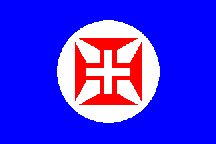
ON Flag
|
New Order Flag (Portugal)
Ordem Nova (ON)
The Portuguese traditional seafaring symbol, the cross of the Order of Christ, did not escape the practice of "National Socialist" type groups to use historical or cultural symbols to falsely represent their organizations, although the Order of Christ cross was originally black on a red background.
The Ordem Nova (New Order), a National Socialist movement operating in Portugal in 1978-1982 used this blue flag with a red cross on a white disc. |
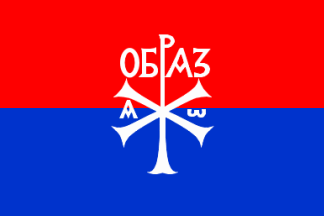
OPO Flag
|
Obraz Fatherland Movement 2002-2012 (Serbia)
Otacastveni pokret Obraz (OPO)
The Obraz Fatherland Movement, founded in 2000, is an ultra-nationalist and extremist Orthodox Christian movement originally led by Nebojša Krstic, a sociologist and theologist. The founding group originally published a magazine called "Obraz" since 1994. The word obraz (cheek) is frequently used as the synonym for "honor." The OPO quickly gained notoriety with its aggressive, and often violent activities against religious and ethnic minorities, as well as anybody else who publicly disapproved of their actions, while simultaneously giving public support to "persecuted patriots" (neo-Nazi skinheads and football hooligans convicted for violence, and persons indicted before The Hague Tribunal). In 2001, Krstic died in a traffic accident (which OPO quickly labeled an assassination), and Mladen Obradovic, a historian, became the new leader. In 2003, a Russian group inspired by Obraz Fatherland Movement, calling themselves Russian Obraz (RO) was started.
The OPO's continuing violent activities eventually led to the Constitutional Court of Serbia declaring Obraz illegal in June of 2012, thus making it one of a few such organizations actually banned in Serbia. Obradovic and a few others were convicted independently for LGBT (Lesbian, Gay, Bisexual and Transsexual) bashing during the Pride Parades in 2009 and 2010 (Pride 2009 was actually canceled, so only passersby were attacked). The OPO was reorganized and re-registered some time afterwards under a slightly different name - Srbski Obraz (Serbian Obraz). Its members contested the parliamentary election of March 2014, were placed on the list of Serbian Radical Partys (no elected representation gained), and are still using the same flag, which was seen during the campaign.
The flag of OPO is red-blue horizontal bicolor with a white emblem composed of the Chi-Rho christogram and word "Obraz" in Cyrillic script, the same symbol serving both as the Rho of the christogram and the "R" in the movement name. The field was borrowed from a modern reconstruction of a 13th Century flag of Serbia which is sometimes used at the events commemorating medieval Serbian history. |
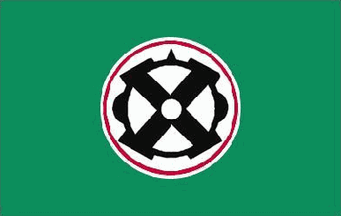
OVN/MNF Flag
|
Organization for National Will / Mexican Nationalist Front (Mexico)
Organización por la Voluntad Nacíonal / Frente nacionalista mexicano
The Organización por la Voluntad Nacíonal (OVN) is a racist national-socialist organization formed in 2007 in Mexico. In 2014, the OVN changed its name to the Mexican Nationalist Front (MNF). They claim to promote a healthy awareness of the Mexican nationality, wish to protect their biological identity, and to lead the fight against those "defeatist historical visions that have left a permanent complex of conquest and resentment."
They are against the "nefarious Masonic heritage of liberalism which left us a republic mediocre and decadent." They also are against ecclesiastical supremacy, international Zionism, Marxism, anarchism, communism, global capitalism, and wish to lead a "peaceful" fight against the U.S. invaders who have seized and occupied more than half their national territory. They look back to the Mexican monarchies of Iturbide and Maximilian, regarding Maximilian's empire as a sincere effort to protect Mexico from Anglo-American influences.
The Organization for National Will flag has their quincunx-like logo within a white circle surrounded by a red and white and green. Besides being the colors of the Mexican national flag, these represent nature (green), spirituality (white) and blood (red). |
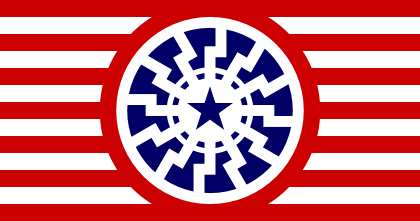
Patriot Front Flag (2017-2018)
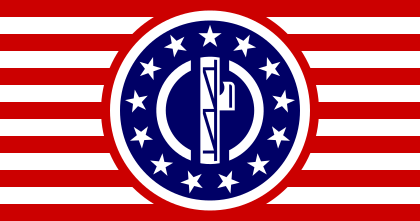
Patriot Front Proposed Flag
(2017-2018)
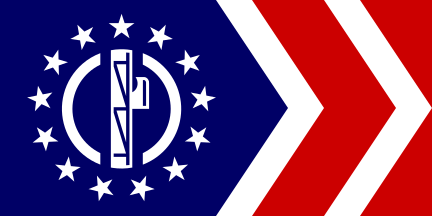
Patriot Front Flag (2018-present)
|
Patriot Front (United States)
Vanguard America-Texas
The trend of the Alternate Right groups is now to reinvent themselves often, usually by simply renaming themselves without much of a change in personal. For example "Vanguard America-Texas" renamed themselves the "Patriot Front". Its leader Thomas Rousseau did so after the violence at the Charlottesville Riots in 2017. James Fields, the neo-Nazi who drove his car through a crowd of counter-protesters in Charlottesville and killed Heather Heyer and injured 19 others, claimed he was a member of Vanguard America-Texas, but was disowned by the group.
|
|
|
First Patriot Front Flag (2x3)
(Vanguard America - Texas) |
|
Patriot Front Flag (2018) (2x3)
(Vanguard America - Texas) |
The flag used by the Patriot Front incorporated the Schwarze Sonne (Black Sun) with star of Texas in middle. The Black Sun is used by a large number of far-right groups who believe in neo-Nazi and/or neo-Volkisch ideologies. The PF propaganda posters usually have the text "Resurrection Through Insurrection," and "Conquered Not Stolen,", usually with a large fascist symbol. Since Charlottesville rarely is the Black Sun symbol has been shown in their literature.
Also see: Vanguard America.
|

PB Flag Type #1
"The West is the Best"
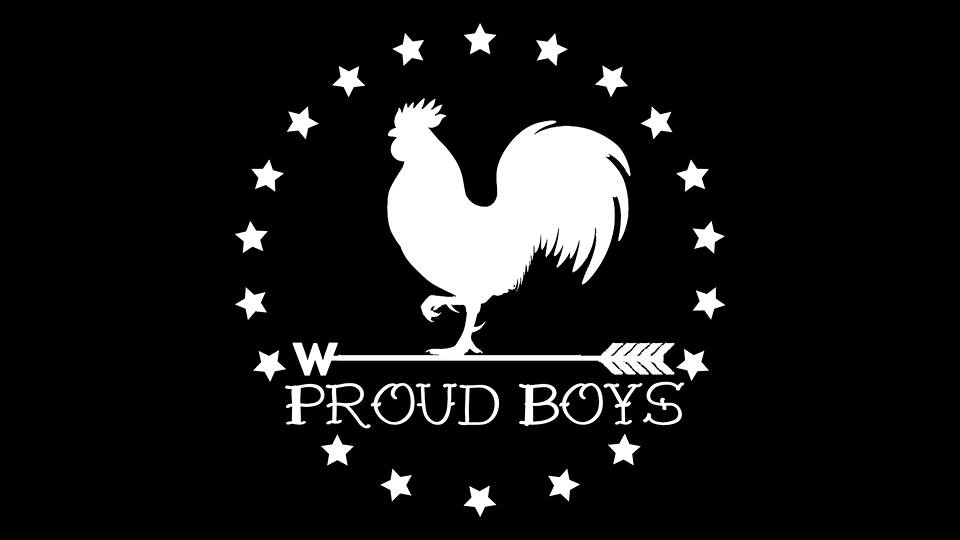
PB Flag Type #2
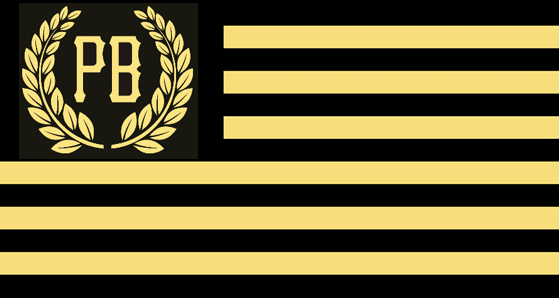
PB Flag Type #3
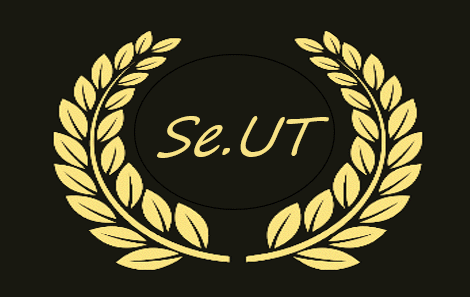
PB Chapter Flag
Possibly "Southeastern Utah Chapter"
|
Proud Boys (United States)
The Proud Boys (PB) are a far-right nationalist organization that sees themselves as protectors of free speech, glorifying the warrior mystic and combat, and are noted for participating in violence with far-left demonstrators, particularly targeting the ANTIFA (anti-fascist). The PB has been dubbed an "alt-right fight club" by the Southern Poverty Law Center (SPLC), and the FBI expressed concern about the potential for violence from individuals within that group. The Proud Boys have also been characterized as racists, ethnocentric, and misogynists in news articles. While it is true the Proud Boys only admit men as members, they do occasionally make mention of their "Proud Boys' Girls". They deny that they encourage violence or gang-like activity.
The Proud Boys were founded in 2016 by far-right political commentator, activist, and comedian Gavin McInnes, who later publicly stepped down from any claim to leadership after several violent incidents occurred. Today the PB consists of multiple splinter groups and chapters across the United States attracting a wide variety of dissatisfied individuals who remain loosely united behind its stated goal to basically promote protection from leftist extremist at political demonstrations and to protect Trump supporters from violence. They view themselves to be libertarian in nature and share a skepticism of authority and state power. They consider themselves free speech activists and feel it is their duty to protect those who attack the protections of the First Amendment. While the group claims not to support any white supremacist views, they do believe in something they call "western values" which they claim is not racism. The PB states it welcomes members from all races, but many of their individual members do often appear in support at racist rallies and events. Proud Boys have also been present at high-profile alt-right events, including the "Unite the Right" rally in Charlottesville, Virginia.
Their self-proclaimed goal is to reinstate what they call the "Spirit of Western Chauvinism" (a philosophy that European culture is basically superior) and to stand against what they call "anti-racial guilt". Their motto "The West is the Best" typifies a refusal to apologize for their belief that Western culture and individuals are responsible for creating the advances of the modern world. Today they seem to be led by a group calling themselves simply "The Elders" and claim to be simply "a drinking fraternity". The chairman of the 8 member Elder Chapter in Texas is Enrique Tarrio, a Florida businessman. Reading Pat Buchanan's Death of the West (in which Buchanan argues that western culture is dying and will soon be imperiled) is encouraged.
Proud Boy chapters have been active across the United States, but also in Canada, Australia, and the United Kingdom. Chapters include the Midwest chapter, the Pacific Northwest/Seattle chapter, the Louisiana chapter, Minnesota Proud Boys, Proud Boys Nashville, Proud Boys Texas, Proud Boys UK, Proud Boys Canada, Proud Boys Australia, Proud Boys Brazil, Proud Boys NJ, and even a branch in the Middle East, to name a few. Their private FaceBook page has over 1,000 followers and it has been claimed they may have more than 3000 members worldwide.
A wide variety of Proud Boys flags, both real and fantasy, have been displayed by chapters of the PB, some of which are illustrated here.
|
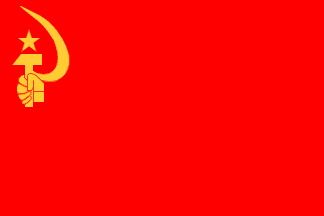
PCE(r) Flag
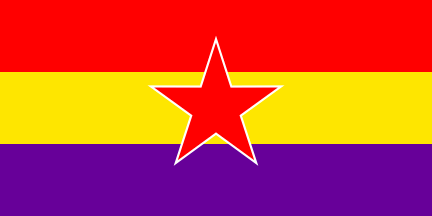
GRAPO Flag
|
Communist Party of Spain - Reconstituted (Spain)
Partido Comunista de España - Reconstituido
The Communist Party of Spain (Reconstituted) was founded in 1975 after the Maoist Organization of Spanish Marxist-Leninists (OMLE Organización de Marxistas Leninistas Españoles) broken away from the old Communist party of Spain in 1968. Its violent armed wing, the First of October Anti-Fascist Resistance Group (GRAPO - Grupos de Resistencia
Antifascista Primero de Octubre), was founded on October 1st of the next year - the day which also saw the murder of four Spanish policemen by the group. It also marks the beginning of the revolution against the Francoist Regime.
The country's transition to democracy did not seem to stop GRAPO's violence, in fact, terrorist actions intensified. As a result, support for PCE(r) and GRAPO has decreased and during the 1980s, the police successfully neutralize the GRAPO. The party was banned in 2003 due to its support for terrorist activities and GRAPO is currently inactive, although both nominally still exist.
The Flag of the Communist Party of Spain (Reconstituted) is red, with a
fist holding both hammer and sickle, accompanied with a five-pointed star, all in gold, placed in the canton. It's terrorist arm GRAPO uses a Spanish Republican tricolor with a red (fimbriated white) star in the center. |
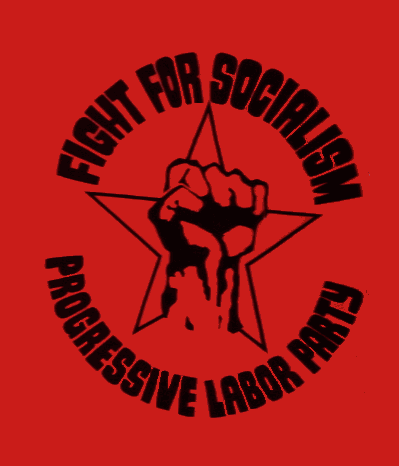
PLP Flag (original)
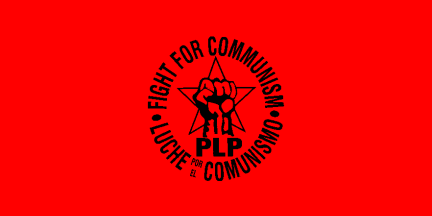
PLP Flag (Type #2)
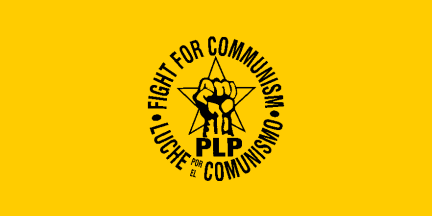
PLP Flag (Type #3)
|
Progressive Labor Party (USA)
The Progressive Labor Party (PLP) is a Marxist-Leninist political party, founded in 1962 in New York City as the Progressive Labor Movement, after splitting from the Communist Party USA. In 1965, it changed its name to the Progressive Labor Party. Milt Rosen, a left wing labor activist, became the founding chair of the Party. The PLP would play a very vocal role in the anti-Vietnam War movements of the 1960s and early 1970s, then emerge as one of the leading Communist organizations in the United States.
Its self-proclaimed goal is to lead a Communist revolution, not only in the USA, but also worldwide. Unlike other American Communist organizations, they insist that the revolution should not result in the establishing of Socialism, which is usually viewed as the transitional phase in classic Marxist political theory, but to the direct introduction of Communism. They consider that Socialism in the United States would just lead to the eventual return to Capitalism, and not to a true Communist state.
During its existence the Progressive Labor Party has published a variety of publications, newsletters, and magazines. Examples would be the monthly newsletter called Progressive Labor (PL) and their magazine Challenge, and a Spanish counterpart they call Desafío.
The first flags of the Progressive Labor Party were usually red, square, with the PLP logo centered on it in black. More modern variants have been rectangular (usually with a 1:2 ratio) in red, or sometimes in dark yellow, with the party emblem depicted in black color in center. The newer emblem consists of a clenched fist drawn over an outlined five-pointed star, with the initials "PLP" beneath it. The device is surrounded with two inscriptions, "FIGHT FOR COMMUNISM" above and "LUCHE POR EL COMUNISMO" underneath (the same thing in Spanish). |
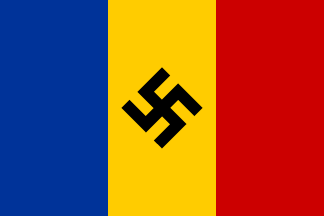
PNC Flag
|
National Christian Party 1935-1938 (Romania)
Partidul Nat'ional Cres'tin - PNC
The National Christian Party (Partidul Nat'ional Cres'tin), a pre-World War II Romanian Fascist Party, was founded in 1935 by the merger of Alexandru Cuza's National Christian Defense League (Liga Apararii National Crestine, LANC) and Octavian Goga's National Agrarian Party (Partidul Nat'ional Agrar). Strangely enough, the PNC seemed to have been modeled after the rival Iron Guard, the main difference being in their shirts, which were blue instead of green. The PNC party banner was the flag of Romania with a swastika in the center. It was associated with extreme anti-Semitism, calling for a gradual withdrawal of rights for Jews and a gradual policy of reapportionment of Jewish land and businesses.
The National Christian Party never received more than about 10% of the vote, but was chosen in December of 1937 by King Carol II to form a government, which lasted only 45 days and was supplanted by the royal dictatorship. During these years, relations between the PNC and the Iron Guard were those of extreme hostility and violence, both groups accusing each other for being used by the Jews in order to suppress the other one.
When the PNC was banned in 1938, it is suspected that most of the membership simply joined the National Renaissance Front (Frontul Renasterii Nationale, FRN) founded by the king. It is noted that Cuza served as a member of the Crown Council after the banning and this suggests that he also had migrated into the ruling FRN. |
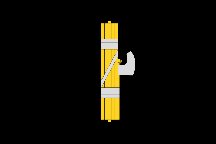
PNF Party Flag
|
Italian National Fascist Party 1922-1943 (Italy)
Partito Nazionale Fascista
The Partito Nazionale Fascista (PNF) was a far-right Italian political party, created by Benito Mussolini as the political expression of fascism. The party ruled Italy from 1922 to 1943 under an authoritarian system.
Fascism advocates the creation of a single-party state. Fascists believe that nations and races are in perpetual conflict whereby only the strong can survive by being healthy, vital, and by asserting themselves in combat against the weak. Fascist governments forbid and suppress criticism and opposition to the government and the fascist movement. Fascist blame capitalist liberal democracies for creation of class conflict which they oppose, and communists for exploiting the concept.
The symbol on the flag is a fasces, a bundle of sticks used as a symbol of authority by officials in Ancient Rome. The sticks represented the power of individuals. By binding them together and inserting an ax, they could not be broken easily. They represented the united power of many working together as one. The fasces is not just a Fascist symbol and is used world-wide, including on the back of the U.S. Mercury dime. |
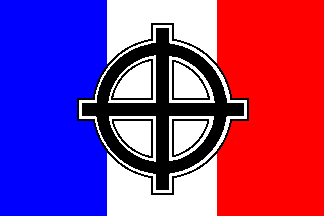
PNF Flag |
French Nationalist Party (France)
Parti Nationaliste Français (PNF)
The French Nationalist Party was originally founded in 1983 by members of the editorial committee of the review "Militant", created in 1967. Following several splits, the party virtually ceased to exist by the middle of 1990s. In 2015, the review called for the reactivation of the party. This was supported by former leadership of dissolved French Work, who called their former members to join in. The party was eventually re-founded on 1st October 2015, with the participation of many successor groups of the French Work, such as the Nationalist Lorraine or The Caryatids. The PNF obtained the written support of Jean-Marie Le Pen, former President of the National Front, who insisted on the past connections with the French Work which were severed when his daughter, Marine Le Pen, replaced him as the party President in 2011.
The party flag is the French tricolor, charged in the center with a large black Celtic cross, outlined in white and black.
|
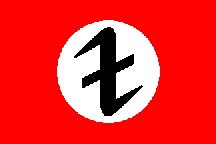
PNN Flag
|
Italian Neo-Fascist Party (Italy)
Partito Nazionale neoFascista
This National Socialist flag features the "Wolfsangel" rune. In a Neo-Nazi demonstration in Vicenza, Italy, they flew this flag. It has the classic Nazi scheme (red background with white circle and a black doppelhaken symbol.
The ancient German rune wolfsangel was a magical means to frighten away wolves. It is also known as the doppelhaken or "Wolf's Hook." The upright variant is known as the donnerkeil" (thunderbolt) and the horizontal variant as the "werewolf." Due to its use by Nazi Germany, along with continuing use by neo-Nazi organizations, the symbol is now associated with Nazism as are many of the old folk symbols of the Germanic peoples, most notably, the swastika. |
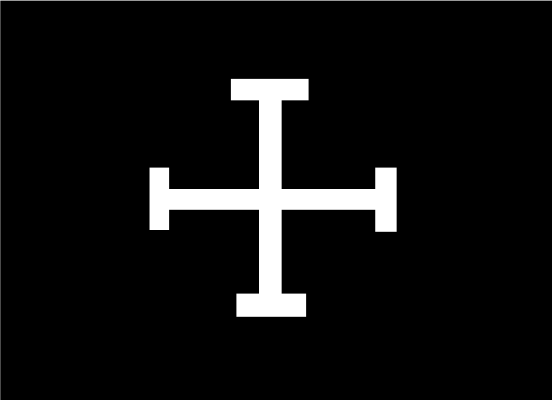
PNPR Cadet Corps Flag
|
Puerto Rican Nationalist Party (Puerto Rico)
El Partido Nationalista de Puerto Rico
The Puerto Rican Nationalist Party (PNPR), founded in 1922, was a violent extremist group whose main goal was Puerto Rican Independence. In 1930, Dr. Pedro Albizu Campos was elected president of the Puerto Rican Nationalist Party, and under his leadership, especially during the years of the Great Depression, the party became the largest independence movement in Puerto Rico.
The PR flag was forbidden in the island from 1898 until 1952, but was flown in defiance by the black-shirted Cadet Corps of the Puerto Rico Nationalist Party. They also had a Cadet Corps' flag all in black with a white Jerusalem Cross in the middle. The Puerto Rican Nationalist Party of New York (El Partido Nationalista de Puerto Rico, Junta de Nueva York) claims to be an American Branch of the PNPR. |
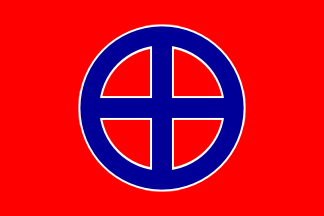
PNS Flag
|
New Fatherland Society (Chile)
Patria Nueva Sociedad (PNS)
New Fatherland Society was founded in 1999 at Puerto Montt, Chile. While describing itself as National Socialist, even being recognized as the successor of National Socialist Workers Party of Chile by its old members, the movement insisted that the nation shall be defined by the culture, rather than the biology/genetics ("race"). In 2006, the Constitutional Court was requested to ban the PNS, which it eventually rejected in 2010, after an unusually long procedure, stating that there is no sufficient evidence in favor of banning. Later same year, the movement dissolved itself, stating that it is impossible to safely operate as a legal National Socialist organization.
Flag of the PNS was red, charged with a large blue sunwheel fimbriated white - a neo-Nazi symbol, but in Chilean national colors. |
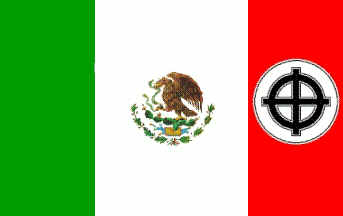
PNSM Flag

Creole Pride Flag
|
Mexican National-Socialist Party (Mexico)
Partido Nacional Socialista de México
The National Socialist Party of Mexico (PNSM), is not a legally registered political party and seems to be mostly active on the internet. Its platform is based on 14 principles referring both to racial supremacy and its ethical and economic foundations.
According to PNSM sources the group has a membership or 35,000 members throughout Mexico. The PNSM claims to have members in Mexico City and the states of Baja California, Jalisco, Nuevo León, Quintana Roo and Chiapas.
The flag most commonly attributed to the PNSM is the Mexican National Flag with the Celtic Cross defacing the red stripe of the flag.
The Mexican National-Socialist Party (PNSM) claims to have a membership that consists of many Mexican Creoles. An Orgullo Criollo (Creole Pride) flag has been seen in use by the PNSM. According to the official PNSM website the flag symbolize the Creole people of Mexico who gained independence during the 19th Century, but strangely enough, although the flag consist of the usual National Socialist design - red background with white circle, the Cross of Burgundy replaces the swastika. The Cross of Burgundy was used by the Spanish in "New Spain" between 1506–1701, when the Conquistadores were busy conquering and killing much of the native population.
|

PNSO Flag
|
National Socialist Workers Party of Chile
Partido Nacional Socialista Obrero de Chile (PNSO)
This party was founded in 1964 and dissolved in 1970. Later attempts to restart the party were unsuccessful and its former members eventually decided to recognize the New Fatherland Society as their successor.
The PNSO copied the German Nazi visual identity completely. This included the use of the unchanged German NSDAP flag. |
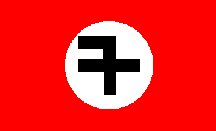
PNT Flag
|
New Triumph Party (Argentina)
Partido Nuevo Triunfo
The Argentine group Partido Nuevo Triunfo(PNT) is presently banned in Argentina, but its flag is still widely used by other racist groups. It was founded in 1990 by Alejandro Biondini, evolving from an internet publication. Biondini ran for president in the 2003 election with little impact. Their flag has the standard red field, white circle, and black emblem of such groups. The swastika-like emblem looks like a crossed number 7.
The party explanation is that it represents Saint Cajetan. Saint Cajetan Day is August 7, and he is the protector of workers, unemployed people and work seekers. |
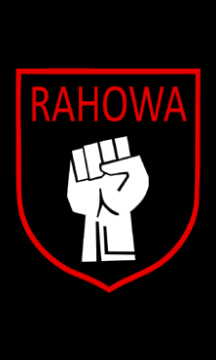
RaHoWa Flag
|
Racial Holy War Flag (USA)
The concept of a Racial Holy War, or RaHoWa, was first suggested by Ben Klassen, the founder of the Church of the Creator. The Church of the RaHoWa, sometimes referred to as the "White Crusaders of the RaHoWa", are a break-away group from the Creativity Movement. The movement believes that White people should unite and undertake a holy war against Jews and non-Whites. The term "RaHoWa" has become a popular war cry for many White nationalist groups, and flags, stickers, and buttons like this shown are quite popular amongst them.
RahoWa was also the name of a Canadian white power rock band that formed in 1989. The lead vocalist George Eric Hawthorne (his real name was George Burdi) was a white supremacist and the owner of the recording company (named Resistance Records) which published the band's music. Burdi was also at one time the Canadian leader of the World Church of the Creator, and not surprisingly the songs on their first album "Declaration of War" were racist with very violent lyrics. Following a RaHoWa concert in Ottawa in 1993, Burdi kicked a fallen female Anti-Racist Action member in the face during the riot, for which he was arrested, convicted, and served a jail sentence. He later publicly renounced racism. |
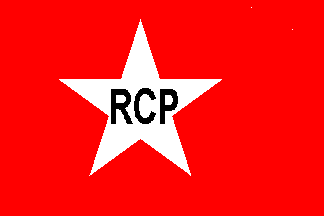
RCP-USA Flag
(black lettering variant)
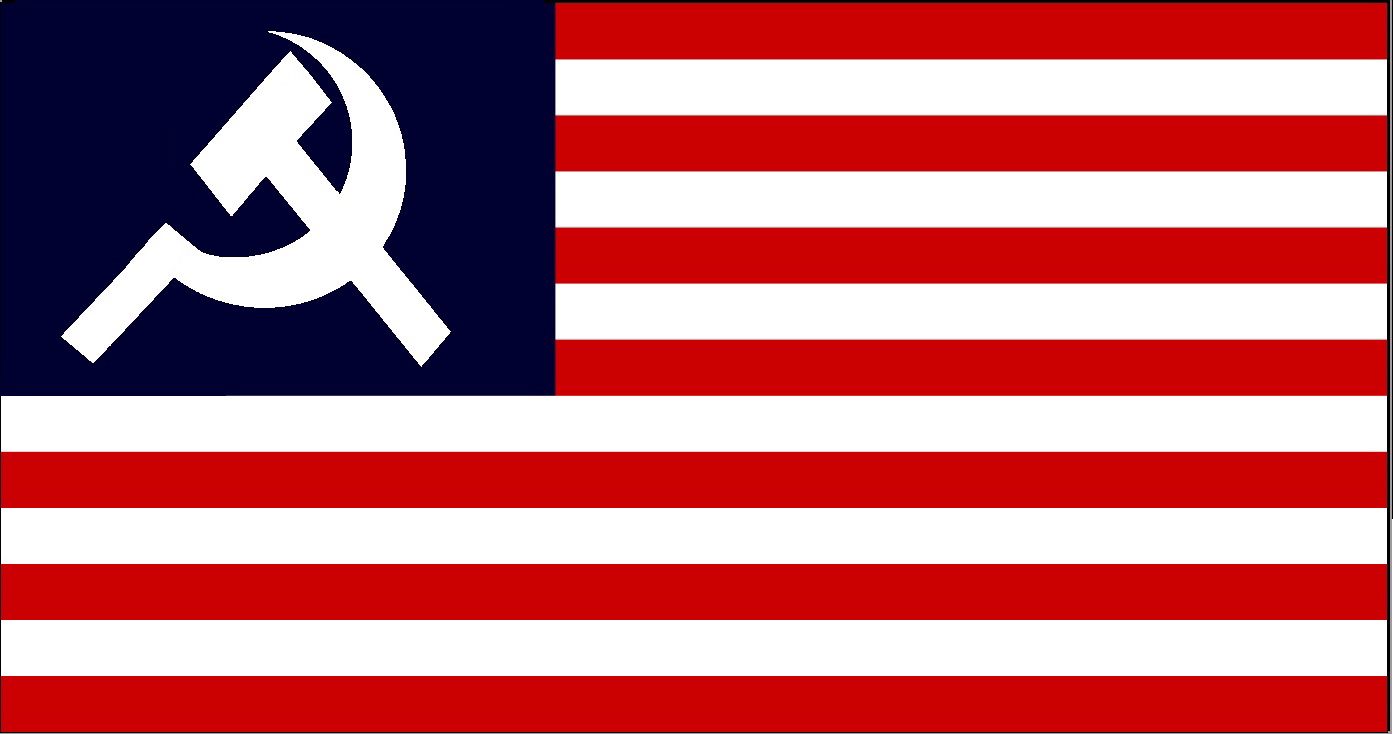
RCP-USA Flag
(un-documented variant)
|
Revolutionary Communist Party, USA (USA)
The Revolutionary Communist Party, USA (RCP-USA), known originally as the Revolutionary Union, is a Maoist Communist party formed in 1975 in the United States. The RCP states that U.S. imperialism will never peacefully end, and that the only way for people to liberate themselves is through revolution. The RCP enthusiastically supported the 1992 violent Los Angeles social unrest in the aftermath of the Rodney King verdicts as a "rebellion," and then-LAPD chief Daryl Gates went so far as to allege that the RCP was explicitly involved in the riots.
The party was led by its elected National Chairman and primary theoretical spokesperson, Bob Avakian. It is one of the few surviving direct descendants of the New Left of the 1960s and 70s. As a result of criminal indictments stemming from a protest against Deng Xiaoping at the White House in 1979, Bob Avakian fled the United States. Because of this, the RCP is active in both the United States and Western Europe. In recent years the party has suffered several splinter groups and power struggles over leadership positions which has further weaken the group.
The RCP-USA generally used a red flag with a white star either centered or off-set slightly to the left as shown here. The letters "RCP" in either black or red are superimposed on the star. Recently, a stars and striped variant has also been reported being used by the group, but this is currently undocumented.
|
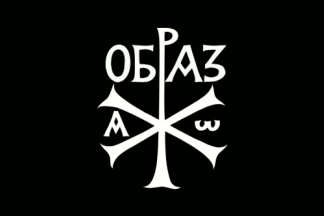
RO Flag Type #1
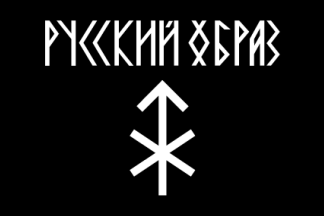
RO Flag Type #2
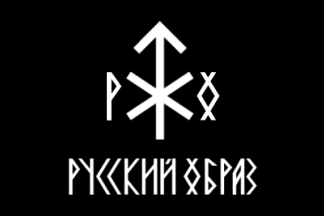
RO Flag Type #3
|
Russian Obraz 2003 (Russia)
Russkiy Obraz (RO)
The Russian Obraz is an ultra-nationalist organization modeled after the Obraz Fatherland Movement, a similar organization from Serbia. Although modeled after the Obraz of Serbia, the Russian organization is somewhat closer to the neo-Nazis, mostly in their tolerance for Russian neo-paganism, for many members are followers of such cults. It should also be pointed out that the name obraz was just copied from Serbian by the Russian RO and that the word has a completely different meaning in Russian, that of "picture" or "image."
The RO proclaim they "are determined to end political correctness and stop the flow of illegal immigrants to our countries – the phenomenon which has created dangerous criminal and social problems" and "Russia should obtain a Russian Mind. We will succeed or Russia will not exist."
The main RO flag (Type #1) is derived from that of its Serbian counterpart by changing the field color - plain black instead of bicolor red-blue.
An alternate RO flag (Type #2) displays a different emblem - runes Tyr and Gebo placed one over the other, which in Russian pre-Christian religion were representing spear and shield of god Perun according to their website. The name of the RO organization is inscribed above the emblem, in a typeface with letter shapes modeled after the runes.
Another RO flag (Type #3) used by the movement has the name of the organization inscribed beneath the emblem, which is amended with the initials "R" and "O", inscribed in the same typeface as the full name.
|
2.gif)
RCYL(b) Flag
3.gif)
RCYL(b) Banner
1.gif)
RCYL(b) Flag (variant)
|
Revolutionary Communist Youth League - Bolsheviks (Russia)
The extreme leftist Revolutionary Communist Youth League (Bolsheviks) was originally founded in Moscow in 1996 by Alexander Batov. It formed after the split of RYCL and considers itself the heir of the most progressive and communist part of the Komsomol (Kommunisticheskii Soyuz Molodyozhi) (All-Union Leninist Young Communist League - AULYCL). In 2000, the RCYL(b) was linked with a plot to place a bomb near the Federal Security Service building and three of its members were arrested in that plot. In 2005, the RCYL(b) cell in Leningrad formed a union with the Lenin Komsomol of Leningrad (LYCLL), and since then RCYL(b) cells have been formed in many regions of Russia and also in several foreign countries.
The activities of the RCYL(b) includes (in their own words): "fighting for the release of political prisoners including RCYL(B) members); helping the Russian Communist Workers' Party (the Revolutionary Party of Communists to set up trade unions independent from the state); fighting for the youth's right to education; supporting the general struggle for social rights; taking part in direct action against the bourgeois regime; training the membership base in ideology and publishing the Revolyutsiya theoretical journal; taking part in the annual National Russian anti-capitalism youth march; running youth camps to strengthen discipline and to train members in guerrilla warfare; publishing a bi-monthly newspaper, the Bumbarash; demonstrating solidarity with the working class and anti-imperialist struggles throughout the world." Unfortunately, many of these activities have turned violent.
On their flag is a portrait of the Cuban revolutionary Che Guevara and beneath him the abbreviation (in Russian) for the Young Bolsheviks "PKCM(b)." There are two different typefaces used, often Times Roman, sometimes with chopped fonts. Ernesto "Che" Guevara was an Argentine-born Cuban revolutionary, Castro's aide who left Cuba after the revolution had been won, to launch other revolutions in other Latin American countries (It seems that he had previously had serious disagreements with the rest of Cuban leadership, although nothing is precisely known about that, nor will be as long as Cuba is a Communist country), and was eventually killed in Bolivia. The photo which is used on many leftist flags throughout the world may have been shot in Bolivia. The photo has became almost an icon for leftists throughout the world. |
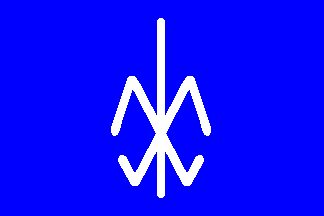
RF Flag
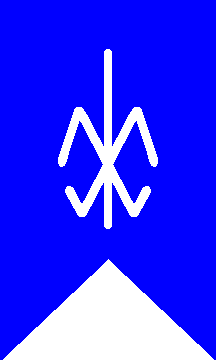
RF Processional Banner
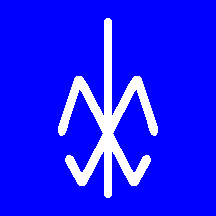
RF Square Flag
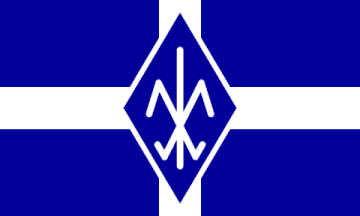
RF White Cross Flag
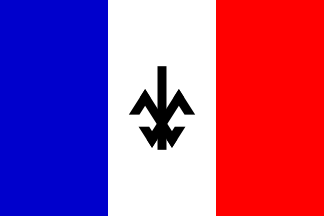
RF Tricolor Flag
|
The French Renewal (France)
Renouveau Français
The French Renewal (RF) is a French ultra-rightist organization, founded in 2005, and affiliated with the European National Front. The RF claims to be nationalist, Catholic and "counter revolutionary," i.e. - against the principles of the French Revolution of 1789. The most common symbol on the RF street literature is a black and white Celtic cross and their swastika-like, stylized fleur-de-lys emblem. Their self-proclaimed goal is to defend and free the "French nation" from the parliamentary system, lobbyist organizations, and what they see as "the fundamentally Masonic, secular, and cosmopolitan Republic." Besides rejecting Freemasonry, they target "Marxism" and what they call "Classical Liberalism."
In the 2000s, the RF more or less "incorporated" with the French National Front and carried their symbols in the FN parades and demonstrations. However, as Marine Le Pen succeeded her father as FN leader and attempted to clean-up the FN party's image, they established a policy of only displaying the French national tricolor at their demonstrations. The result was a split and, accordingly, the RF has re-emerged as a completely separate movement again.
|
|
|
RF Finistère Department Section |
|
RF Yvelines Department Section |
The flag of Renouveau Français is blue with the white stylized fleur-de-lis emblem of the movement centered in the middle. It is most often seen in the nationalist demonstrations scheduled every year in May in Paris, also in a square variant during last years. The movement also uses a "processional banner," made of a vertical, swallow-tailed version of their flag, as well as a blue flag with white cross and a blue diamond over all, charged with a white fleur-de-lys and fimbriated white. A tricolor flag with a black, differently stylized fleur-de-lys in center was originally used as well, but seems to have fallen out of use. Local sections are gradually introducing their flags as well, combining the fleur-de-lys with local emblems; those from Finistère and Yvelines departments were the first to do so.
|
|
|
French Traditionalist Catholic Flag Type #1 |
|
French Traditionalist Catholic Flag Type #2 |
|
|
|
French Traditionalist Catholic Flag Type #3 |
|
Traditional Île-de-France Banner |
Other flags reported being used by the RF during their demonstrations include a French tricolor defaced with the symbol of the Sacred-Heart-of-Jesus, a Sacred Heart centered on a plain white field, white flag with multiple golden fleurs-de-lys and the Sacred Heart over all (all three borrowed from the Traditionalist Catholics) and the traditional provincial Île-de-France heraldic banner with three golden fleur-de-lys on blue. |
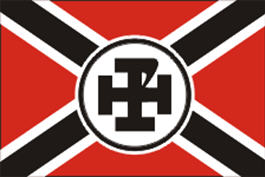
RNS Flag
|
Russian National Union (Russia)
Russkiy Natsional'niy Soyuz (RNS)
The Russkiy Natsional'niy Soyuz (RNS) is a neo-Nazi party based in Russia. The party grew out of the followers of Konstantin Kasimovsky, a leading member of Pamyat in the immediate aftermath of the collapse of the Soviet Union. He split from the Pamyat-led National Patriotic Front in 1992 and formed his own party, the Russian National Union, the following year. This party re-emerged as the "Russian National Socialist Party" (RNSP) in 1998.
The party bases itself on four principles i.e. Orthodox Christianity, a strong state, aggressive Russian nationalism and non-Marxist socialism. The party symbol is the Labarum of Constantine the Great and since 1999 have published a newspaper "Right Resistance," itself a successor to the earlier journal "Stormtrooper." |
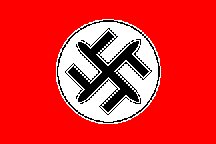
RNU Flag

National Unity Flag (Type 2)
|
National Unity of Russia (Russia)
Rossiyskoye Natsional'noye Yedinstvo (RNU)
The Rossiyskoye Natsional'noye Yedinstvo (RNU) is a far right, ultra-nationalist political party and paramilitary organization based in Russia and operating in states with Russian-speaking populations. It was founded by the ultra-nationalist Alexander Barkashov and claims to have 20,000 members, making the National Unity the largest extremist organization in Russia.

National Unity Flag (Type 3)
There are reportedly 120 nationalist organizations displaying fascist and neo-Nazi symbols in Russia, the most prominent are the Russian National Union, Russian National Council and the Russian National Unity. All these groups are xenophobic (distrust of strangers), antisemitic (hate Jewish people), and blame all of Russia's problems on a imagined "Jewish and Zionist Conspiracy." |
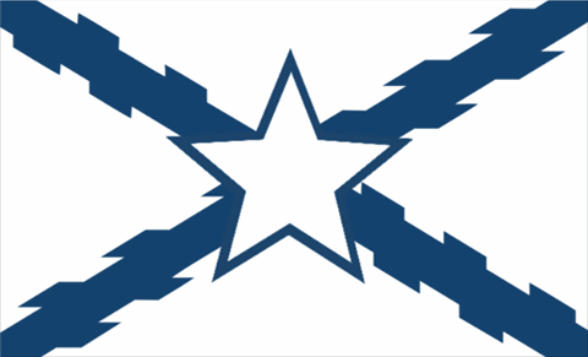
Original ROF Flag (Type #1)
(first reported - existence questioned)
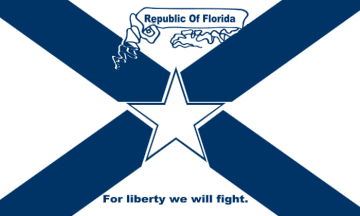
ROF Flag (Type #2)
"The Liberty Flag"
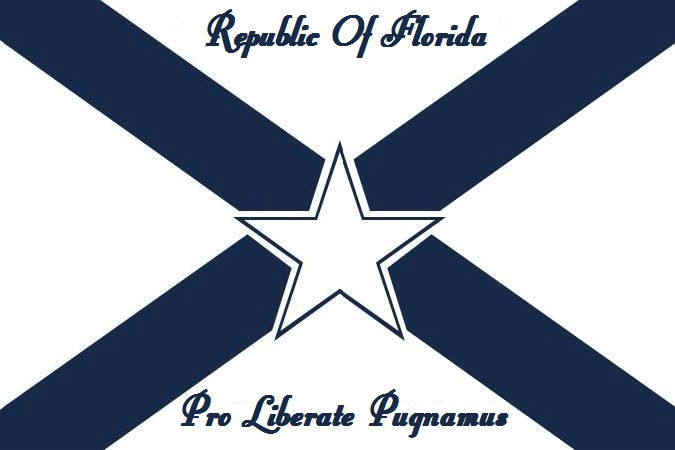
ROF Flag (Type #3)
"The Freedom Flag"
(imaged only - existence questioned)
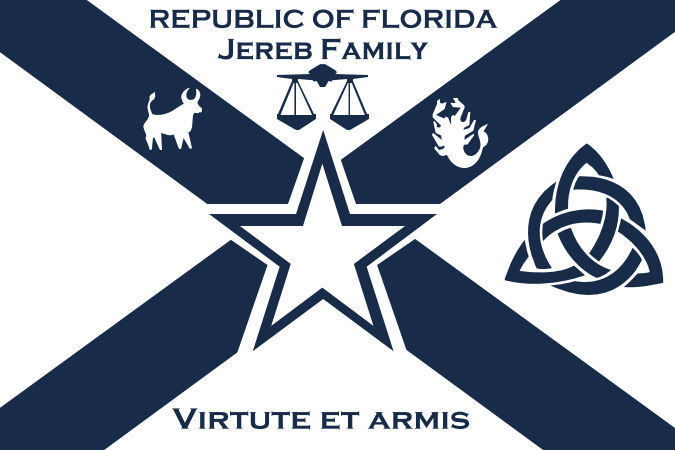
ROF Flag (Type #4)
"Jereb Family Flag"
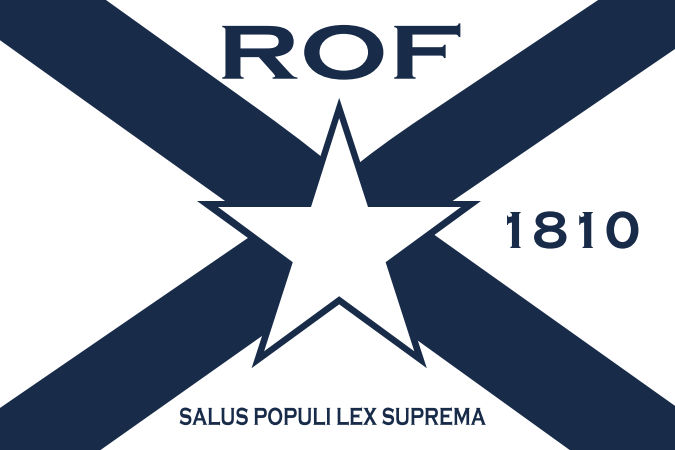
ROF Flag (Type #5)
"The Safety Flag"
(imaged only - existence questioned)
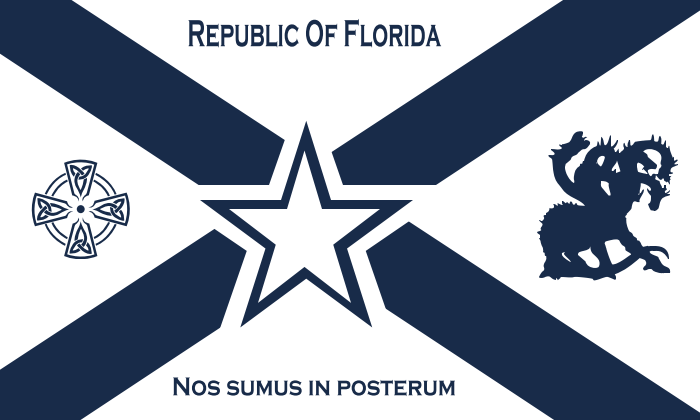
ROF Flag (Type #6) "The Hydra Flag" 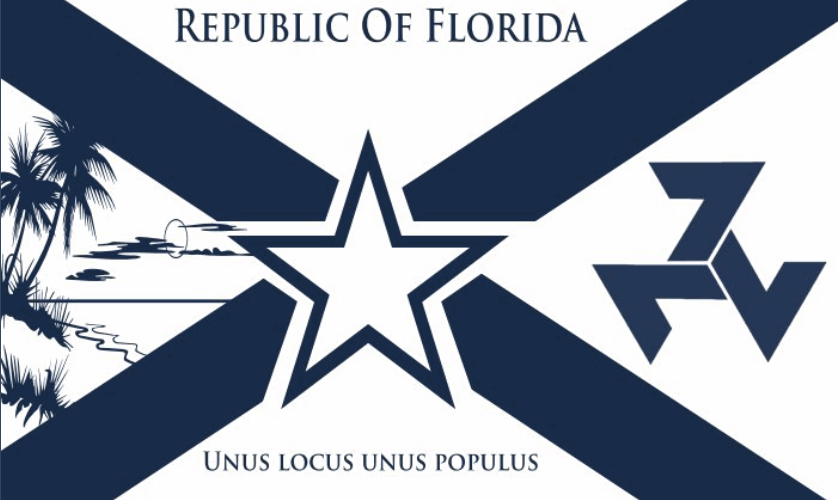 ROF Flag (Type #7) "The Blood And Soil Flag" |
Republic of Florida Militia (USA)
The Republic of Florida Militia (ROF), similar to the Real Republic of Florida (RROF), appears to be a small neo-Confederate anti-gun control group, located in the Tallahassee area of Florida. The ROF describes itself as a part of a small community of similar fractured groups, organized, "just as the Irish Republican Army was." They consider themselves to be "the armed forces of the provisional government of the Republic of Florida" and the "prime force at arms to protect the republic." Their self-proclaimed mission is to "fight and die for the white star flag!" Barely a month after being released from jail on burglary charges, ROF leader Jordan Jereb professed his love for Molotov cocktails and recommended a video giving instruction on when it's okay to shoot a police officer.
|
ROF Militia Company Guidon
(imaged only - existence questioned)
|
The Republic of Florida Militia's "White Star" flag (Type #1), combines a blue Cross of Burgundy with the 'white star' (outlined in blue) of the Republic of West Florida, both centered on a plain white field. A variant of the ROF White Star Flag (Type #2) is charged with a blue "fimbriated" white star over a standard blue saltire, separated with white-blue fimbriation (outline) where it merges into the white field. Above the star, there is inscription "Republic of Florida" in blue on a white ribbon outlined in blue. On white field beneath the star, there is a blue inscription stating "For liberty we will fight."
The Type #3 variant follows the same pattern, but has the Latin Pro Liberate Pugnamus (We fight for freedom) beneath the cross. The family flag of ROF militia leader Jordan Jereb (Type #4) features the St. Andrews Cross and white fimbriated star, but utilizes the colors black and white instead of the blue and white. Above the cross and star appear the words "Republic of Florida" and "Jereb Family" in block lettering and a justice scale. Beneath the cross and star it contains the Latin virtute et armis (power and weapons). An Irish or Celtic Trinity Knot (Triquetra) Symbol appears to the right side, or fly side, of the cross. The St. Andrews Cross is further defaced with three symbols (from left to right) - bull, justice scales, and scorpion (the Zodiac signs for Taurus, Libra, Scorpio) which are the signs of Jereb, his daughter and wife. The Type #5 variant has the Latin phrase Salus populi lex suprema (Safety of the people is the highest law) below the cross and 1810 on the fly side honoring the short-lived Republic of West Florida in the western region of Spanish West Florida.
The ROF Hydra flag (Type #6) design follows that of previous ROF flags, but with these differences. On the white field beneath the Star is the Latin Nos sumus in posterum (We are the future). On the hoist side of the cross of Saint Andrew is a circle of four symbols of the Trinity, framed in a shields. This symbol has also been found on rune stones in Scandinavia, in ancient goddess-oriented pagan groups, in Celtic manuscripts, and on early Germanic coins. It is associated with numerous mythical gods and goddesses and has been used as a protective charm by Wiccans. On the right or fly side of the cross is the Hydra, a symbol meaning the conquest of a very powerful enemy. The Hydra of myth is a nine-headed water serpent with the ability to regrow a head (or two) if it is severed.
An interesting variant is called the Blood and Soil Flag Type #7 which shows a drawing of a couple of Palm tree growing on a Florida beach on the left side of the blue saltire and the triskele symbol on the right. Above the saltire are the words "Republic of Florida" and beneath is the Latin Unus Locus Unus Populus (One Location One People).
Shown below are two ROF flags only seen as images on one of their earlier websites.
|
|
|
ROF AK Flag
(imaged only - existence questioned) |
|
ROF Don't Tread on Me Flag
(imaged only - existence questioned) |
However, it should be noted, that according to the militia they have multiple companies that use variants of their flag. All these flags feature the St. Andrews cross and white star or are a variation of the Bonnie Blue flag utilizing the colors blue and white. The flags use these symbols as they "give all the young folks in the local cells something to be proud of. Symbolism is a powerful non-violent weapon for our cause." The militia also uses the traditional Bonnie Blue Flag of West Florida, the Florida State Flag, and the Confederate State of Florida Flag at their demonstrations or on their website. |
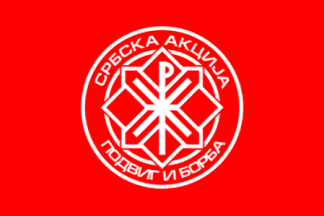
SA Flag (Type #1)
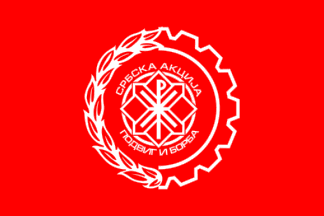
SA Flag (Type #2)
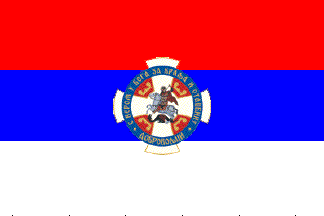
Serbian Volunteer Corps
(World War II Zbor Flag)
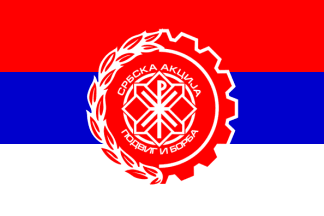
SA Flag (Type #3)
|
Serbian Action
Srbska Akcija (SA)
Serbian Action (SA) is a Serbian ultra-nationalist organization founded in 2009-2010, which draws its inspiration from the Serbian People's Movement "Zbor", originally a pre-World War II ultra-rightist movement, but briefly resurrected in the early 2000s. The SA might even be considered the successor to this "reanimated" movement of the 2000s, because they have adopted some of the Zbor symbols and propaganda. The SA also has ties with other extremist groups such as the New Right of Romania and the Golden Dawn of Greece, having incorporated similar racist ideas and some of their symbolism into its ideology.
|
|
|
Sun Wheel Flag (Type #1)
(borrowed from Golden Rule and others) |
|
Sun Wheel Flag (Type #2)
(borrowed from Golden Rule and others) |
The flag of Serbian Action is red, charged with its emblem in white, colors shared with the Zbor of 2000s. The original emblem consists of a Chi-Rho christogram superimposed over the outline of an eight-pointed star, all superimposed over a smaller ring and surrounded with a larger one. Between the two rings are the name of the organization at the top and the motto "Valiance and struggle" (Podvig i borba) at the bottom.
A newer variant (Type #2) replaces the larger ring with combined outlines of wheat-ear, borrowed from the symbols of original Zbor, and cog wheel.
They also use the traditional "Celtic Cross" flags (or "Sun Wheel" type flags) which are in common use by many other extremist groups worldwide. The Serbian Action is also fond of using the flag of Serbian Volunteer Corps, a World War II military formation founded and used by the original Zbor.
The Type #3 Serbian Action Flag, uses a newer version of the SA emblem placed on the tricolor field of the Serbian national flag. It was adopted in 2016. |
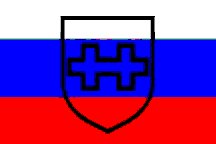
SA Flag
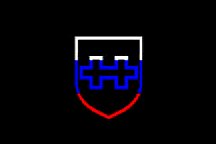
SA Flag Variant
|
Northern Alliance
Party Flag (Russia)
Sevyerniy Alliyans
The Russian Sevyerniy Alliyans (SA) is the third largest neo-Nazi party in Russia, after the RNSP and the RNU.
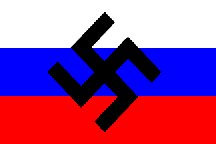 |
|
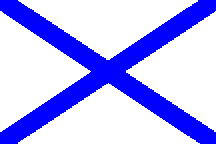 |
| Tricolor with Swastika |
|
Russian Naval Ensign |
The Northern Alliance uses four different flags: The two double cross shield versions, the Russian tricolor with swastika, and the old ROA flag of General Vlasov's army, which collaborated with the German Army and Reich during World War II (also known as the Flag of Russia and Russian Naval Ensign). |
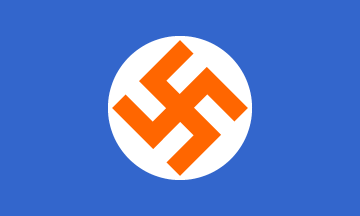
SANP Flag
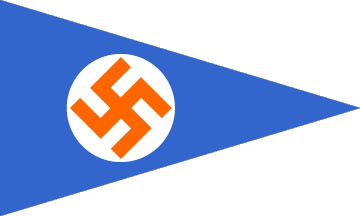
SANP Pennant
|
South African Nazi Party (South Africa)
South African Gentile National Socialist Movement
Greyshirts - Gryshemde
In the 1930's a number of groups sympathetic to Nazism emerged in South Africa, but perhaps the best known was the South African Nazi Party (SANP), known more simply as the Gryshemde (Greyshirts) because of their paramilitary Sturmabteilung-like uniforms. Their official names of the "South African Gentile National Socialist Movement," and the "South African Christian National Socialist Movement," was rarely used. The group, which remained active during the 1930s and 1940s, was started by Louis Weichardt. Its platform was the basic Nazi hate and anti-Semitic propaganda.
Headquarter in Capetown and Pretoria, the Greyshirts published a newsletter called simply the "Bulletin" where they attempted to justify the actions of the National Socialists both in Germany and South Africa. What was unusual about this particular South African extremist group was that they sought to work with both the Afrikaans and the English-speaking populations at the same time.
As the Jews fled Nazi Germany during the mid-1930s, many relocated in the Cape Town area of South Africa and the Greyshirts organized large street rallies protesting this Jewish immigration. The government closely monitored these Greyshirts activities, especially during World War II, and by 1949, the Greyshirts, now calling themselves the White Workers Party, gradually faded from South African political life. |
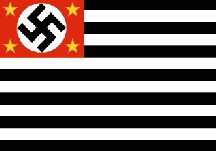
São Paulo neo-Nazi Flag
|
São Paulo Neo-Nazi Movement Flag (Brazil)
The largest concentration of Brazilian neo-Nazi are in São Paulo, an industrial city of more than 10 million people. Today, an estimated 1,000 neo-Nazis live in the city. Their policies still contain hatred of Jews, blacks, and homosexuals. They also advocate the secession of the more prosperous southern Brazil from the rest of the country.
A new major theme of Brazilian neo-Nazis is hatred of Nordestinos (Northeasterners), people from the impoverished Northeastern states who have migrated in increasing numbers to the large cities in search of a better life. The issue parallels immigration problems in Europe and the United States, stimulating the same popular fears of job loss and insecurity. Brazil's neo-Nazi, like their counterparts elsewhere, thrive on such fears. |
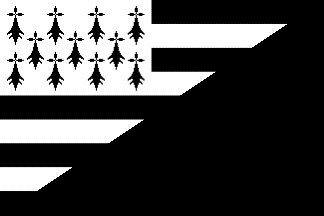
Scream! Flag (Type #1)
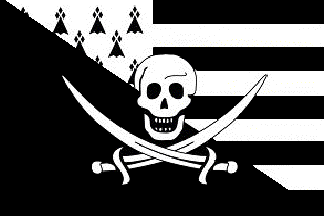
Scream! Flag (Type #2)
|
Scream! (Brittany, France)
Disuj!
Scream! is a Breton far-left nationalist anarcho-independentist organization which, founded first in 2001 as the Coordination Bretagne Indépendante et Libertaire (CBIL), was renamed Scream! (Disuj!) in 2012. Scream has consolidated several local movements, such as Huch! (in Rennes), Treger Disuj (Tregor), Ti an Dispac'h (Pontivy), Kailh Du (Lorient) and Strollad Lochu (Brest) into a larger regional organization. They publish a newsletter called "The Megaphone" (Le Huchoèr). Although nationalism in the province of Brittany in France can almost be considered a traditional pastime since medieval times, the blending of traditional Breton nationalism with the extremist beliefs of anarchism can be considered an explosive combination.
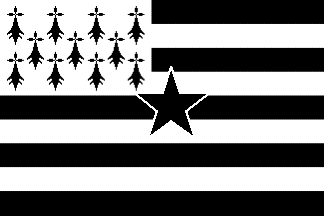 Scream! Flag (Type #3) Disuj! uses two flags based on a blend of the traditional province flag of Brittany and the black anarchist flag (Type #1 and Type #2). A third flag has been used in "The Megaphone," published in eastern Brittany, and superimposes a black Anarchist star centered on the traditional Gwenn-ha-Du Brittany flag. |
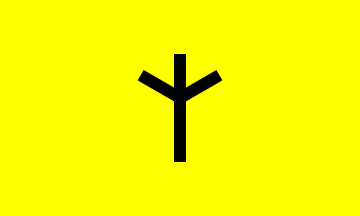
Scottish Dawn Flag
|
Scottish Dawn (United Kingdom)
Scottish Dawn was founded in early 2017, allegedly by fomer members of various organizations, as a Scottish ultra-nationalist ("Identitarian") movement. After an investigation by the Home Office, the group was banned in September 2017 as the legal cover for National Action, which had been banned in December 2016, shortly before the Scottish Dawn was founded.
The flag of Scottish Dawn, as seen in many photos which have appeared online during its short existence, was yellow with black algiz rune in center. The rune is a popular neo-Nazi symbol, but the colors were probably borrowed from the Identitarian Bloc of France, the alleged model for Scottish Dawn. |
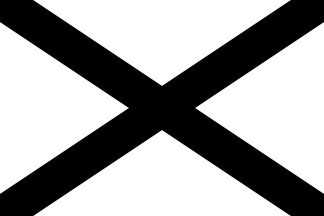
SNN Flag
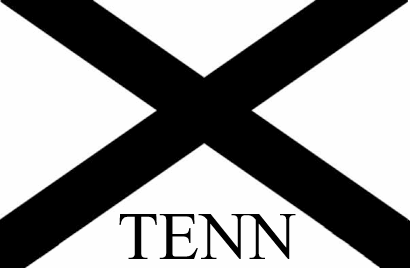
Tennessee SNN Flag
|
Southern Nationalist Network (USA)
The Southern Nationalist Network (SNN) was created in 2010 by a group of modern day Southern separatist whose goal seems to be, once again, the establishment of Southern independence. This neo-Confederate extremist group views the South as an occupied nation, and feel themselves to be "at odds with anything that comes out of Washington, DC, and with the tone of the general culture across the US as a whole."
The Southern Nationalist flag, a black saltire on white field, was introduced as the "symbol of neo-Confederate extremists in the USA" in 2013 by the Southern Nationalist Network. The white is said to stand for "European heritage, hierarchy, tradition," and black symbolizes "Southern nationalism." Besides being featured on the SNN website, the League of the South, a neo-Confederate organization, use the SNN Flag at its demonstrations in the towns of Uvalda and Vidalia, Georgia, in 2013.
At the violent White Nationalist Alt-Right demonstrations and riots in Charlottesville in 2017 several variants of their flags were seen, including one that apparently was being displayed by a group from Tennessee. There may have been a small black period after the second "N". |
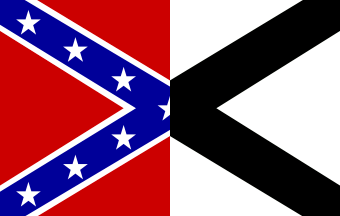
SN Flag
|
Southern Nationalist/Neo-Confederate (USA)
Neo-Confederate, or "Southern Nationalist" is a term used to describe the views of various groups and individuals who portray the Confederate States of America and its actions in the American Civil War in a positive light. Originally designed by a former member of the Neo-Confederate League of the South (LOS), the "Southern Nationalist" flag and its variants are intended to evoke memories of the St. Andrews Cross and the Confederate Battle Flag (CBF).
Variants are frequently carried by members of League of the South, the Southern Nationalist Network, and their allies in the south. During the violent White Nationalist Alt-Right demonstrations and riots in Charlottesville in 2017 several variants of these flags were prominently displayed. |

SLA Flag
|
The Silver Legion of America 1933-1942 (USA)
The Silver Legion of America, or Silver Shirts, were an American fascist organization founded by a Hollywood screenwriter named William Dudley Pelley in 1933. The paramilitary Silver Shirts wore silver colored shirts with a dark blue tie and military riding pants as their uniform. The shirt had a large red letter "L" over the left pocket. Their flag had a silver field with the red "L" in the canton. By 1934, the Silver Legion could claim about 15,000 members.
The main headquarters of the SLA was in Asheville, North Carolina, but in 1935, they began construction of a fortified bunker compound in a remote 55 acres in the Los Angeles hills which was designed to serve as their world headquarters after a Fascist global conquest. After the Japanese attack on Pearl Harbor in December of 1941, and the US entry into World War II, Los Angeles police raided the "world headquarters" bunker compound and detained the 50 SLA troopers "stationed" there. Pelley went into hiding, was eventually arrested at his new base of operations in Noblesville, Indiana, and charged with high treason and sedition in 1942. The treason and sedition charges were dropped, but he was convicted on lesser crimes and sentenced to 15 years imprisonment. He was paroled in 1952. |

SNP "Zbor" Flag
c2000s
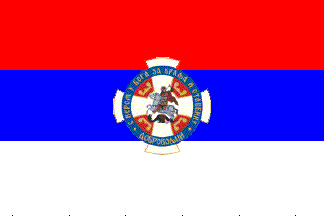
SVC Flag
1941-1945
|
Serbian People's Movement "Zbor" (Serbia)
Srbski narodni pokret "Zbor"
This group claims claims to be the successor of the Yugoslav People's Movement "Zbor" (Jugoslovenski narodni pokret "Zbor"), which was founded in 1935 by a fusion of several pro-Fascist groups from various parts of Yugoslavia. Zbor (rally) is also an acronym for Združena borbena organizacija rada (United Combative Organization of Labour). The Zbor was founded by Dimitrije Ljotic, who preached a strange blend of authoritarianism, corporatism, monarchism, anti-Communism, anti-freemasonry, Orthodox Christian fundamentalism and anti-Semitism, plus encouraging an alliance with the Third Reich and Fascist Italy. By 1940, when a hostile Yugoslav government banned the SNP, it evolved from an all-Yugoslav into a Serbian-only organization. However, after the occupation in 1941, the Zbor re-organized as the Serbian Volunteer Corps (Srpski dobrovoljacki korpus - SVC), and actively assisted the occupational forces in the persecution of Jews in present-day Serbia, as well as in the repression against other Serbians (a policy of 100 executed civilians for one killed German soldier).
In 1945, Ljotic was killed in a car accident while fleeing and many of his followers were later extradited, tried and executed. Those who successfully escaped to Germany maintained their exiled organization for years, although they have been generally rejected by the mainstream Serbian diaspora. After the collapse of Communism, there were constant efforts to re-introduce the ideas of Zbor in Serbia, but with very limited success.
The original Zbor used a number of emblems, but seemed to have had no flag of their own. The only related flag was that of the Serbian Volunteer Corps, which is now sometimes used by modern ultra-rightists, and adds the unit badge to the national tricolor: a "Kosovo Cross" between four fire-steels which are taken from the national coat of arms, over all the image of St George slaying the dragon and inscriptions S verom u Boga za Kralja i Otadžbinu (With Faith in God, For King and Fatherland) and Dobrovoljci (Volunteers). The re-founded group uses a red flag with white "Kosovo Cross" between four fire-steels, arranged so as to resemble both the Serbian Volunteer Corps badge and a Celtic cross. |

SS Flag
(Type #1)
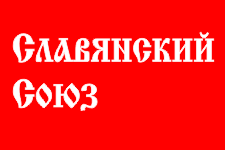
Slavic Union Party Flag
(Type #2)
|
Slavic Union Skinheads (Russia)
Славянский Союз
The far-right Slavic Union, claiming to be Russia's National Socialist Movement, is led by Dmitry Demushkin, and is one of a number of Russian nationalist groups with neo-Nazi tendencies. The group's Russian initials spell SS (CC), its members give Nazi-style salutes, and its main flag features a reworked swastika. The group has claimed responsibility for several murders and attacks on Jewish organizations, websites, and groups. They claim kinship to the Russian Nation Union and other Russian extremist organizations such as the National Patriotic Front.
|
|
|
Slavic Force Flag (Type #1) |
|
Slavic Force Flag (Type #2) |
The Slavic Union was recognized as an extremist organization and banned by the Moscow City Court in 2010, and by the Supreme Court of the Russians the next year. After the Slavic Union was banned, the Slavic Force (Slavyanskaya sila) was founded by Dmitry Demushkin to replace it. The organization uses either red or black flags with the name of the organization in white, inscribed in two lines in a medieval-looking typeface, following the previous practice of the Slavic Union. |

SRN Flag
|
System Resistance Network (United Kingdom)
System Resistance Network (SRN) was founded in June 2017 as Vanguard Britannia, the UK chapter of Vanguard America. The new name was adopted as part of distancing from the Vanguard America after the Charlottesville car attack in August 2017, since the perpetrator appeared to be their member. There are also claims that they are linked to the National Action, the neo-Nazi group banned in December 2016, although these seem not to have been proved so far.
The SRN emblem consists of a lightning bolt over a sword, both over a ring. This resembles the symbols of both British Union of Fascists and National Resistance/Black Front of Germany. On the flag, it is displayed in white on black field, much like the flag of National Action; this similarity is thought to speak in favor of the connections between two groups. |
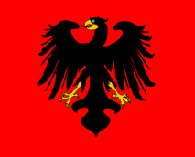
SRP Flag
|
Socialist Reich Party of Germany (Germany)
Sozialistische Reichspartei Deutschlands (SRP)
The Sozialistische Reichspartei Deutschlands (SRP) was a West German political party founded in the aftermath of the Second World War, in 1949 as an openly National Socialist and Hitler-admiring split from the German Empire Party. Leading figures included Otto Ernst Remer and Fritz Dorls. It denied the existence of the Holocaust, claimed that the USA built the gas ovens of the Dachau concentration camp after the War and that films of concentration camps were faked. The SRP also advocated a reunited Europe, led by a German Reich, as a "third force" against both capitalism and communism.
The SRP had its own paramilitary organization, the Reichsfront, and the youth wing, Reich Youth (Reichsjugend). The SRP was banned in 1952 by the Federal Constitutional Court of Germany. |
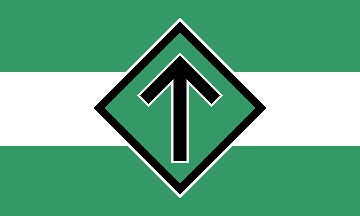
SMR Flag (type #1)
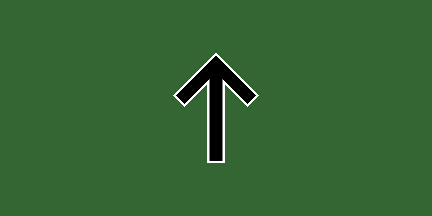
SMR Flag (Type #2)
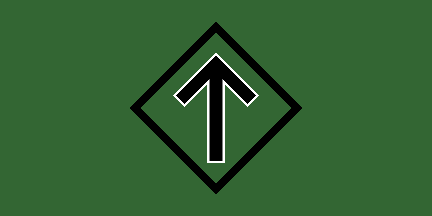
SMR Flag (Type #3)
|
Swedish Resistance Movement (Switzerland)
Svenska Motståndsrörelsen
The Swedish Resistance Movement (SMR) is a Swedish, militant Neo-Nazi organization that exists in Stockholm, Göteborg, Malmö and Linköping. The Leader is Klas Lund, former member of White Aryan Resistance (VAM), and convicted of manslaughter.
The aims of Swedish Resistance Movement is to establish a Nordic government by revolution. The organization says their fight will require bloodshed. Like many neo-Nazis and white nationalists groups, they call themselves the resistance, because they consider themselves to be fighting Jewish-Marxist tyranny.
The organization is mainly known for their links to heavy criminality. According to the Swedish Security Service, the SMR is the Neo-Nazi Group which is the biggest threat against Sweden's inner security. Their main tactic is handing out leaflets about crimes committed by foreigners and immigrants in Sweden, arranging public rallies and training their members in martial arts and other physical activities such as marches and paintball. Their camps in the Swedish woods have left some people to believe they are training for a civil war or a revolution. In November 2003, the Swedish Security Service raided homes of leading members, among them Klas Lund, who was later sentenced to prison for illegally possessing a firearm.
In 2008, these flags "transplanted" themselves to Finland and the Finnish Resistance Movement (SVL - Suomen Vastarintaliike), another neo-Nazi group, started by Henrik Holappa, a former member of the Finnish "True Finns" (Perussuomalaiset) Party. Their activities seem to mirror those of the Swedish group. |
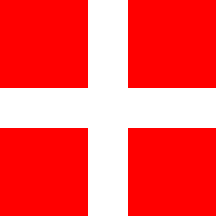
SNF Flag
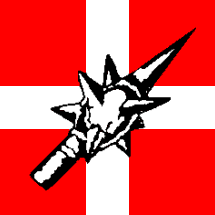
PNOS Flag
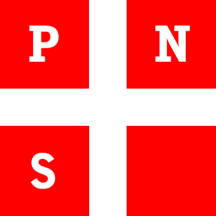
Old Swiss Cross Variant
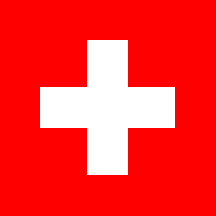
Actual Swiss National Flag
|
Swiss National Front (Switzerland)
Schweizer Nationale Front
The Swiss National Front (Front Nationale) was founded in 1933 in Zurich as a merger of different right wing groups. The SNF began among the debating clubs of the University of Zurich, where anti-Semitism, Swiss nationalism, and support for the racial policies of Nazi Germany was popular. Its anti-semitic message was published in the student party newspaper, Der Eiserne Besen (The Iron Broom), became widely read. The party, under the leadership of Rolf Henne, supported a national referendum in 1935 that sought to change the Swiss government into a nationalist, racial, and authoritarian state, but was it was soundly defeated. Henne lost the party leadership in 1938 to Robert Tobler and his followers left to form the Nationale Bewegung der Schweiz (National Movement of Switzerland or NBS). In 1940, the SNF was temporarily dissolved and reformed as the Eidgenössiche Sammlung (Swiss Federal Collection/Gathering/Assembly) after Tobler was imprisoned for espionage, but two years later, in 1943, the party was completely disbanded.
Swiss Nationalist Party/Party of Swiss Nationalists (Switzerland)
Partei National Orientierter Schweizer
In 2000, a far-right völkisch political party calling itself the Partei National Orientierter Schweizer (Party National of Orienting Swiss or PNOS), but commonly referred to in English as simply the "Swiss Nationalist Party" or "Party of Swiss Nationalists", was founded by Jonas Gysin and Sacha Kunz, who claimed it to be the successor of the old National Front. Its activities seem to be centered in the Swiss-German parts of the western Swiss plateau.
The "total" or "throughout" Swiss cross (extended to meet the edges of the flag) was present on many far-right Swiss flags during the 1930s and was meant to look more like the ancient Swiss banners. These flags were also used after World War II by such groups, although in recent years the official Swiss national flag (and cantonal flags) have been more commonly used. The PNOS also uses a variant of the National Front flag, but defaced with its logo.
The PNOS often uses the "Old Swiss Cross" flag adding the party name initials in three corners. The abbreviation is actually that of the French-language name of the party - Parti Nationaliste Suisse or Swiss Nationalist Party.
The actual Swiss National Flag is shown here for comparison, illustrating the differences between the national flag and the "Old Swiss Cross" flag used by the PNOS. |
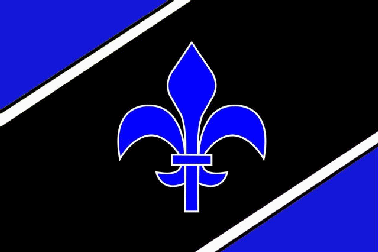
Blue Solutrean Flag
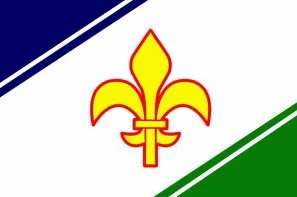
Gold Solutrean Flag
|
Solutreans (USA)
John de Nugent, a white racist and nationalist who ran for sheriff in Armstrong County in Pennsylvania under the motto of "For God, Guns, Guts and Glory" has designed several flags alluding to the idea the Solutreans, a prehistoric culture in France who he claims are the true ancestors of all white North Americans. According to de Nugent the Solutreans crossed the Atlantic in the Ice Age, but were later massacred by the ancestors of the "Asiatic" Indians who arrived later. He also believes in aliens who "are good, bad and neutral and form alliances like earthly nations." He also claims Barack Obama's real father was Franklin Marshall Davis, a black Communist, and that the Jews and Arabs are descended from the Neanderthals.
The first of his two Solutrean Flags has a blue fleur-de-lys with a white border on a black diagonal stripe, fimbriated in white, running from the lower hoist to the upper fly on a blue filed.
The Second variant features a black diagonal center stripe (also fimbriated in white) with a gold fleur-de-lys with red border, a blue upper diagonal field and a green lower diagonal field.
It is unclear if these flags actually exist or are simply graphic images used on his website. |
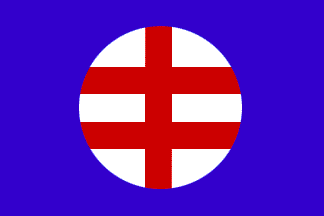
Hlinka Guard Flag
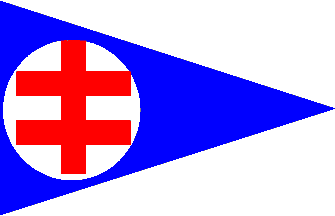
Hlinka Guard pennant
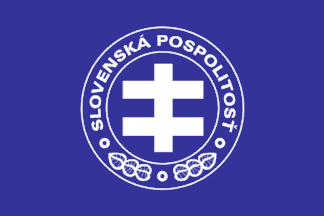
Slovak Solidarity Flag
(Type #3)
|
Slovak Solidarity - National Party (Slovakia)
Slovenská pospolitost - národná strana
The Slovak Solidarity is an ultra-rightist political organization in Slovakia which was founded in 1996 by high school teacher Marian Kotleba. It claims to draw inspiration from the Slovak People's Party, which was founded in 1906 when the country was still part of Austria-Hungary. Initially supporting the creation of Czechoslovakia in 1918, this party soon turned to struggle for independent Slovakia, eventually creating a Nazi puppet state in 1939, to be dissolved along with it in 1945. Registered as a party in 2005, Slovak Solidarity was banned in 2006 by the Supreme Court, the first such action in modern Slovakia, but kept operating as a political association again until 2009, when its members founded the People's party Our Slovakia.
The flags of Slovak People's Party and its militia, the Hlinka Guard (named after Andrej Hlinka, the party leader in 1913-1938), consisted of a blue field with a white disk, which bore a red double cross, its shape differing from flag to flag. This was loosely based on the national coat of arms.
|
|
|
Slovak Solidarity Flag
(Type #1) |
|
Slovak Solidarity Flag
(Type #2) |
The flag used by the Slovak Solidarity had a black or blue field with a centered white circle containing a white double cross. This was later changed into a blue flag charged with the complete emblem of the party. The emblem has a blue disk with white double crosses surrounded with a blue ring with white edges, which is charged with the party name and two sets of three linden leaves, the three charges separated by three rings, all in white. |
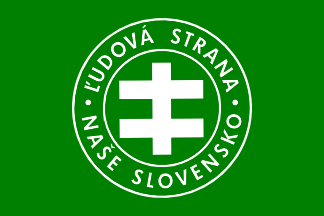
People's Party Our Slovakia
|
Kotleba - People's Party Our Slovakia
Kotleba - Ludová strana Naše Slovensko
The party was originally founded in 2000 as the Party of Friends of Wine (Strana priatelov vína), a liberal ecologist party. In 2009, the members of ultra-rightist political association Slovak Solidarity have joined this tiny party, inactive since 2006 due to serious financial problems, effectively taking it over and renaming into the People's Party of Social Solidarity (Ludová strana sociálnej solidarity). Next year, the party was renamed again into the People's Party Our Slovakia (Ludová strana Naše Slovensko) and name of the party leader (previously also the leader of Slovak Solidarity) was added in 2015.
Party flag and emblem are derived from those of the Slovak Solidarity, but their field color was changed into green. In the emblem, the ring surrounding the double cross is now charged with the party name only.
|
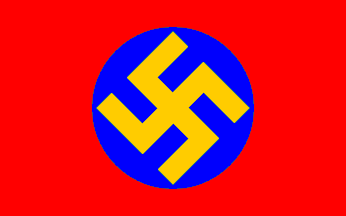
SNSP Flag
|
Swedish National Socialist Party 1930-1936 (Sweden)
Svenska Nationalsocialistiska Partiet
The Swedish National Socialist Party was founded in 1930 by combining several smaller Nazi groups into the New Swedish National Socialist League (Nysvenska
Nationalsocialistiska Förbundet) which was renamed the Swedish National Socialist Party the next year. At that time, its leader Birger Furugard saw himself as the future riksledare (fuehrer or leader) of Sweden, but the party suffered from a serious split in 1933, when large number of members broke away under the leadership of Sven Olov Lindholm, Furugard's deputy, and formed the National Socialist Workers Party, which quickly became the strongest Nazi movement in Sweden. In 1936, following a meagre performance in the national elections, the party was disbanded.
The SNSP used a red flag, charged with a gold swastika on blue disk. This flag was later one of the flags adopted and used by the National Socialist Workers Party. |
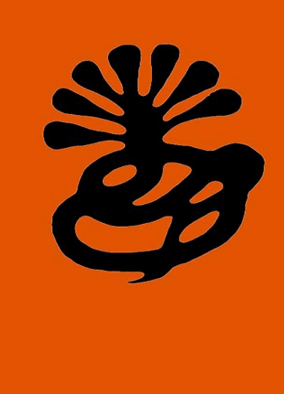
SLA Flag
|
Symbionese Liberation Army 1973-1975 (USA)
The Symbionese Liberation Army, or United Federated Forces of the Symbionese Liberation Army, was a small but extremely violent American left-wing revolutionary group active between 1973 and 1975. During this time the SLA committed several bank robberies, and killed school superintendent Marcus Foster and badly wounded his deputy, Robert Blackburn, as the two men left an Oakland school board meeting. Perhaps the best known was the kidnapping of the 19-year-old publishing heiress Patty Hearst, who was abducted from the University of California in Berkeley, California, then either brainwashed or forced to become involved in several SRI activities, including Bank Robbery.
The leader of the group was Donald DeFreeze, who explained that "Symbionese" represented the symbiosis of ideals of the group. The SLA used a seven-headed hydra-like cobra as their symbol on their hate propaganda and printed materials, including at least one flag that was used as a backdrop for their propaganda photographs. |
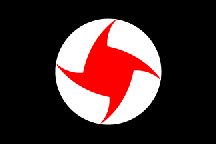
SSNP Flag
|
Syrian Social Nationalist Party (Syria)
al-Hizb as-Suri al-Qawmi al-Ijtima`i, or Parti Populaire Syrien
The Syrian Social Nationalist Party (SSNP) is a far-right political party in Syria and Lebanon. The party policies have been heavily influenced by Italian and German fascist ideology, which was reinforced by its imitation of the external symbols of the Nazi Party. It advocates the establishment of a Greater Syrian nation-state spanning the ancient Fertile Crescent, including present Syria, Lebanon, Iraq, Jordan, Israel, the Palestinian territories, Cyprus, Kuwait, Turkey and the Sinai Peninsula of Egypt.
SSNP was first founded in Beirut in 1932, became a major Syrian political force in the early 1950s, but was outlawed in 1955. In 2005, SSNP was again organized and joined the Ba'ath Party-led National Progressive Front (prior to that, it had been the greatest rival to the Ba'ath Party). In the 2007 election, SSNP won 2 out of 250 seats in the Syrian parliament. |
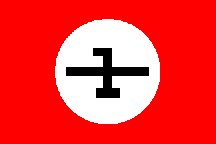
Simorq Bird Party Flag
.jpg)
NASKA Party Flag
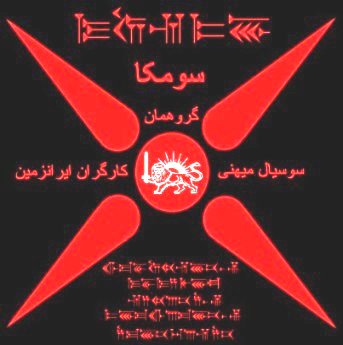
SUMKA Party Flag
|
Iranian National Socialist Workers Party (Iran)
Hezb-e Sosialist-e Melli-ye Kargaran-e Iran (SUMKA)
Hezb-e Nasional Sosialist-e Kargaran-e Iran (NASKA)
The Hezb-e Nasional Sosialist-e Kargaran-e Iran (NASKA) was an Iranian neo-Nazi party, also refered to as the Iran National-Socialist Workers group, was opposed to Mosadegh's democratic government (1950-1953) and expressed a strong neo-Nazi ideology. It was a very small organization and disappeared very quickly during the early 1950s.
However, recently a new group calling itself Hezb-e Sosialist-e Melli-ye Kargaran-e Iran (SUMKA), claiming to be direct heirs of the original group, has become active in Iranian politics.
The original group was formed in 1952 by Davud Monshizadeh (an Iranian Azeri), a professor at Ludwig Maximilians University of Munich, who served with the SS and been injured fighting in Berlin. Before this the name had been used informally to refer to those in Iran who supported Adolf Hitler during the Second World War.
Today, SUMKA runs a few wandering websites (quickly opened, then quickly closed), still teaching their versions of the fundamental beliefs of the Iranian National Socialist ideology to a new generation, although they have never regained their past popularity. Membership has dropped to basically a few members. Their ideology is still based on Anti-Semitism (against Jews) and Anti-Hemitism (against Arabs) and glorifying the "Aryan Identity," but they have drastically modified their views about racialism, World War II, and Nazism.
The original flag of SUMKA had the emblem of a stylized Simorq Bird from Shanameh Ferdowsi at the center. An interesting variant occasionally used by SUMKA was combining a World War II Nazi German War Ensign with the Persian Eagle in the canton. The new style for the SUMKA flag has Lion, Sun, and a straight edge Persian sword at the center of the Derafsh Kaviyani (ancient Persian banner) symbol, with both Persian Spike Alphabet (Khat Mikhi) and Modern Persian Alphabet writings around the logo.
|
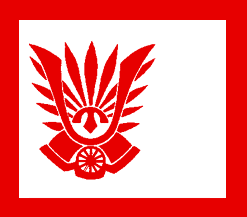
Tate no Kai Flag
|
Shield Society 1968-1970 (Japan)
Tatenokai/Tate no Kai
The Tatenokai (Shield Society) was a short-lived militia claiming their goal was to defend traditional Japanese values and restore imperial power to the Emperor. It was founded in 1968 by Yukio Mishima, who was a writer for an obscure right-wing college newspaper called the Ronso Journal. With a total membership of less than 100, the Tatenokai still managed to briefly train with the Japanese Self-Defense Forces.
In 1970, Mishima and Masakatsu Morita, a Tatenokai student leader, managed to seize control of the Self-Defense Force's headquarters and attempted to rally the soldiers to seize power and restore imperial rule. It failed after Mishima and Morita committed seppuku (ritual suicide). The remaining Tatenokai, were apparently not involved, but the society disbanded.
In 1977, two former members of the Tatenokai, Yoshio Ito and Shunichi Nishio, made the news when they led a small group of Japanese nationalists seizing 12 hostages at the headquarters of Keidanren (Japan Federation of Economic Organizations). All hostages were safely released after an eleven-hour standoff, thanks to an intervention by Mishima's widow, Yoko. |
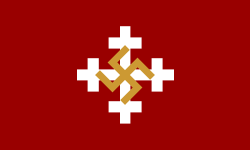
Thunder Cross Flag
(original)
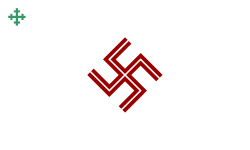
Thunder Cross Flag
(briefly used in the 1990's)
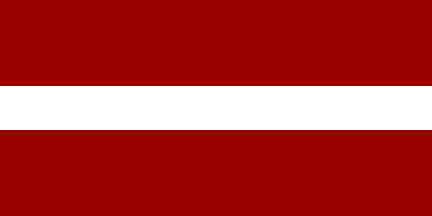
Latvian National Flag
|
Thunder Cross (Latvia)
Perkonkrusts
Thunder Cross was founded in 1933 after the banning of its predecessor, the Fire Cross (Ugunskrusts), which had been founded in the previous year. Both organizations were led by Gustavs Celminš and named after their symbol, the swastika. Their goal was an authoritarian state with a corporatist economy, with eventual elimination of ethnic minorities by assimilation and replacement of Christianity with Dievturiba, a Latvian neo-pagan movement founded in 1925. Thunder Cross was banned along with all other parties after the President Karlis Ulmanis' coup d'etat in 1934 and many members were imprisoned. After the Soviet occupation of Latvia in 1939, the persecution was expanded, many members being deported to Siberia. Thunder Cross was briefly legalized after German occupation in 1941, then banned again. Some members truly supported the Nazis, even assisting in the Holocaust, while the others, including Celminš himself, just pretended to support, while trying to create an underground resistance movement, which led to their eventual arrest in 1944. Imprisoned in Germany, Celminš was liberated by the U.S. soldiers in 1945, moved to the USA in 1949 and stayed there for the rest of his life.
The party flag is dark red, with a gold swastika over a white cross crosslet (Krustukrusts). These two symbols originate from the Dievturiba religion. Red and white colors are borrowed from the national flag of Latvia.
In 1995, Thunder Cross was re-founded, effectively ending its activities by 2000, after many members had been imprisoned for terrorism. It was eventually banned in 2006, to be replaced by the Gustavs Celminš Center (Gustava Celmina centrs), which still promotes the same ideas under the leadership of Igors Šiškins, formerly imprisoned Thunder Cross activist who was later repeatedly arrested for wearing forbidden symbols in public. Along with its original flag, which is still in use, a different design was briefly used in the 1990's, with a large swastika, bearing the pattern of national flag, in center and a small green cross crosslet in canton, all on white field. |
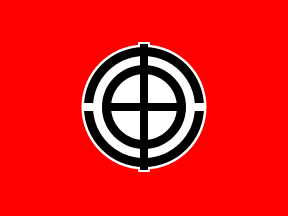
Japanese Fascist Flag
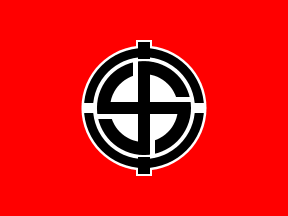
Japanese Fascist Flag
(Swastika variant)
|
Tohokai 1936-1945 (Japan)
The Tohokai (Far East Society) was founded in 1936 by Seigo Nakano who advocated a fascist Japan. Their flag design was based on the Japanese letter meaning "east" and on the swastika. The ultranationalist Tohokai party supported the Imperial Japanese Navy and pressured the government to halt what they considered the Imperial Army's overly-ambitious aim of conquering all of Asia. This brought them in conflict with the pro-Imperialist faction led by General Hideki Tojo, who supported the interests of the Japanese Army and the continued conquest of the rest of Asia.
After Tojo's appointment as Prime Minister, Nakano unwisely continued to be verbally critical of the Tojo regime. He eventually was forbidden to publish articles or make public speeches. He committed seppuku (ritual suicide) in 1943 after being placed under house arrest.
The Tohohai Swastika Flag is based on the original flag of Tohokai with the addition of the swastika in the center replacing the stylized "Sun Wheel" design. It must be remembered that the swastika is very popular in Japan because it has been used as the symbol in Japanese temples for hundreds of years before the adoption of it by the National Socialist German Workers Party in the late 1920s.
The modern National Socialist Japanese Workers Party (Nationalsozialistische Japanische Arbeiterpartei), also called the New Axis, have been known to use versions of these flags. |
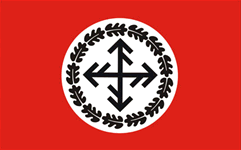
TF Flag #1
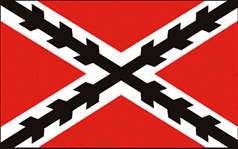
TF Flag #2
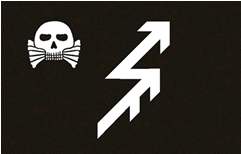
TF Flag #3
|
Third Force (Columbia)
Tercera Fuerza
The Third Force (Tercera Fuerza), calling themselves a "cultural association," spread the usual distorted neo-Nazi version of the National Socialist world viewpoint. This small group, centered in the City of Pereira, operates a website openly under the protection of Article 20 of the Constitution of the Republic of Colombia, which guarantees full freedom of expression. They trace their origins back to 1956 and the original Third Force movement, whose main goal was to preserve their "pure" Hispanic Heritage.
|
|
|
TF Flag #4 |
|
TF Flag #5 |
|
|
|
TF Flag #6 |
|
TF Flag #7 |
Claiming that their flags and banners represent the "expression, tradition, and respect for the ideals and legacy of their heritage," they seem to spend a great deal of their time designing flags, seven examples of which are shown here. |
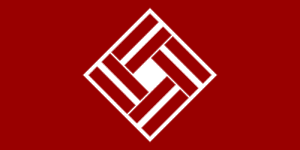
TM Flag
|
Fatherland National Forces Union 2008
Daugava - For Latvia 2010
Fatherland Heritage 2012 (Latvia)
Tevzemes nacionalo speku savieniba/Daugava - Latvijai/Tevzemes mantojums
The party was founded in 2008 when the Fatherland Union (Tevzemes savieniba), a small nationalist party founded in 2000, was reinforced by many former members of recently disbanded National Force Union. Having achieved no significant results, it was replaced after several renamings with the National Union "Justice" in 2014.
While the party emblem was the same as used by the National Force Union, the flag differed in having the plain red field, same shade as in the national flag.
|
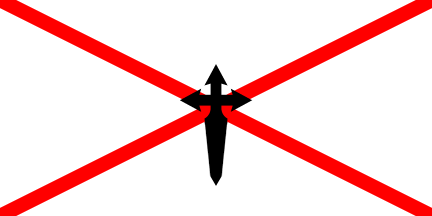
TNSNC Flag
|
National Socialist Tercios of New Castile (Peru)
Tercios Nacional Socialistas de Nueva Castilla
This National Socialist group was active in Peru in the early 2000s and one of the founding organizations of the Peruvian National Socialist Union in 2008. The Tercios, translated as "Spanish Third", or "Spanish Square", was a famous Spanish infantry formation introduced in the 15th Century, and New Castile was the original name of Peru after the Spanish conquest in 16th Century.
The TNSNC, like many other neo-Nazi movements, maintained a lightly armed, brown-shirted private militia in the "stormtrooper" tradition, under a white flag with a simplified red "Cross of Burgundy" defaced with a stylized black cross "dagger," which combines the neo-Nazi Arrow Cross and the Spanish Cross of Saint James. |
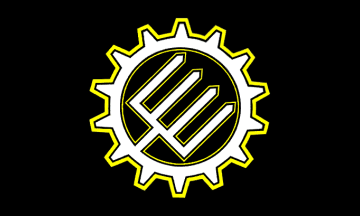
TWP Flag
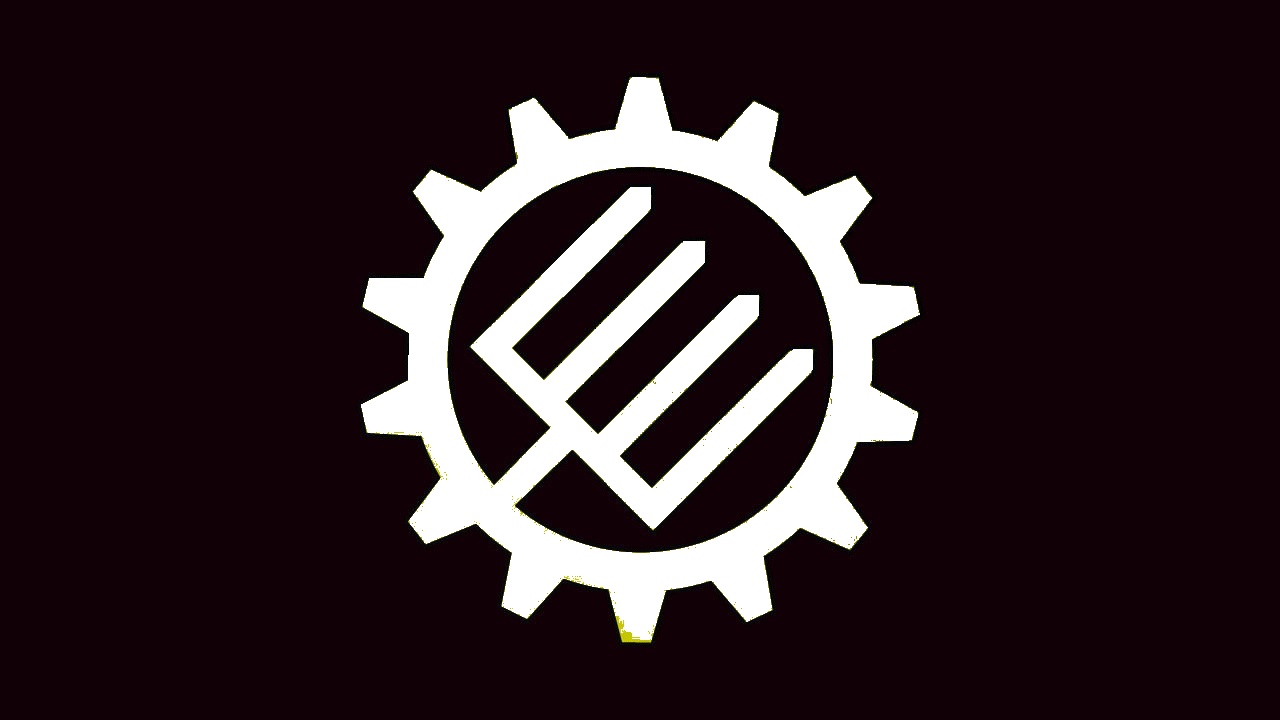
TWP Flag
Simplified White Emblem Variant
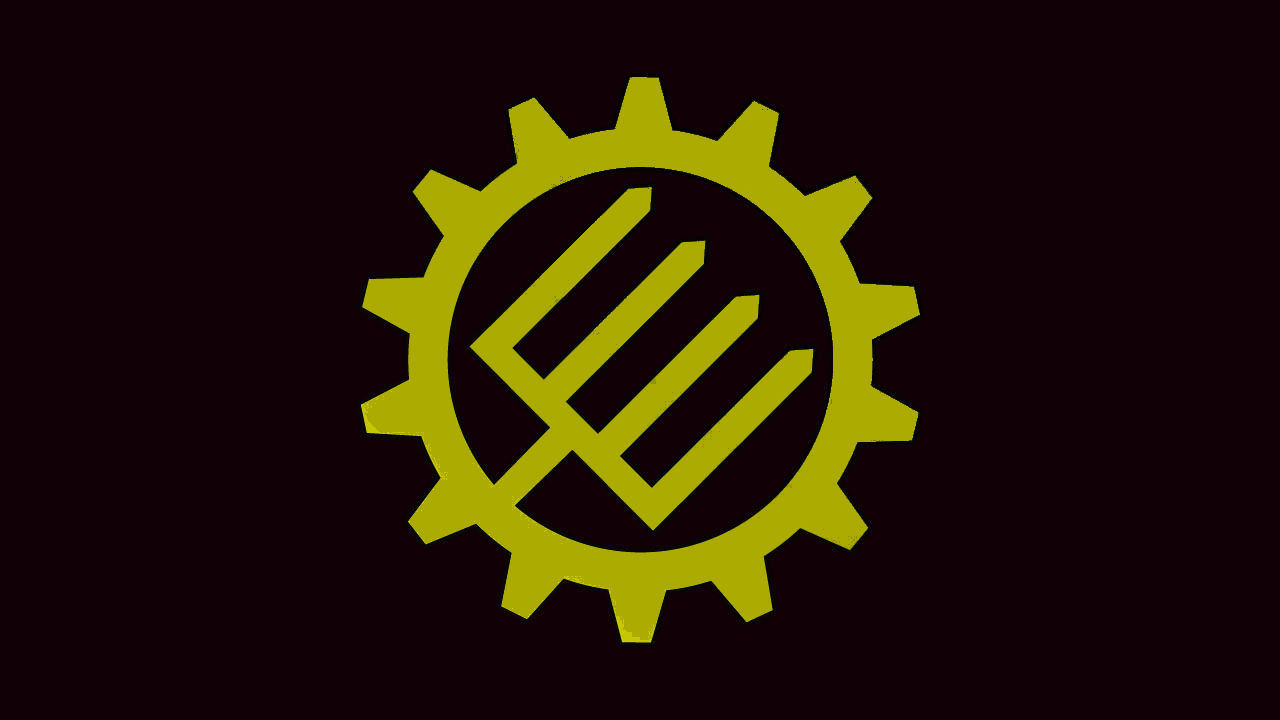
TWP Flag
Simplified Gold Emblem Variant
|
Traditionalist Worker Party (United States)
The Traditionalist Worker Party (TWP) is a white nationalist group that advocates for racially pure nations and communities and blames Jews for many of the world's problems. Even as it claims to oppose racism, saying every race deserves its own lands and culture, the group is intimately allied with neo-Nazi and other hard line racist organizations that espouse unvarnished white supremacist views.
In 2013, Matthew Heimbach, leader of the White Student Union at Towson University in Maryland, joined with Matthew Parrott to found a white nationalist group they dubbed the Traditionalist Youth Network (TYN). Two years later in 2015, they created the Traditionalist Worker Party (TWP) as the political wing of the TYN.
In July 2016, the neo-Nazi National Socialist Movement (NSM) announced that the TWP had joined its Aryan Nationalist Alliance (ANA), a coalition of white nationalist organizations.
The original flag of the TWP seems to have consisted of a white cog-wheel with an attached slanted four-pronged pitchfork placed on a black field. The emblem had a double fimbriation in yellow and black; the inner fimbriations was very thin, while the outer black one was somewhat wider and the outermost yellow one was so wide that it is not really a fimbriation, but a border. The emblem size seems to have varied somewhat, and the same might also be true for the ratio.
Since then the TWP flag, still consisting of a gold stylized cog-wheel with an attached slanted four-pronged pitchfork placed on a black field, has seen some variants appear. On the TWP website the logo appears to show the cog-wheel emblem with graduated gold coloring, and some of the reported physical flags seems to display a simplified non-fimbriated emblem in a solid gold color. As part of the White Nationalist Alt-Right demonstrations held in Charlottesville in 2017, the white cog wheel variant flags were prominently displayed on the nationally televised coverage. |
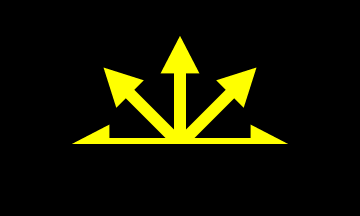
TYN Flag
|
Traditionalist Youth Network (United States)
The Traditionalist Youth Network (TYN or Trad Youth) was established in 2013 by white supremacist Matthew Heimbach and Matt Parrott. The TYN eventually evolved into the Traditionalist Worker Party (TWP) in 2015, but the Trad Youth has remained active on campuses under its old name, essentially becoming a youth wing of the TWP.
The TYN used an emblem composed of five arrows in a radial pattern, the horizontal two only partly visible. It looks like the top half of the symbol of Chaos, which was created by British writer Michael Moorcock and used in his fantasy stories. The logo which is used on the flag, also appears on the arm bands, posters and propaganda distributed by the group. It is depicted in yellow/gold color on black field.
|
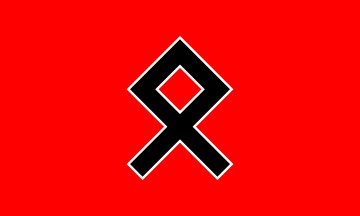
UNSP Flag
|
Peruvian National Socialist Union 2008-2009 (Peru)
Unio'n Nacional Socialista Peruana
The short-lived Peruvian National Socialist Union was founded in 2008 on Hitler's 119th birthday. Their two founding groups were the National Socialist Movement "Peru Awake" (Movimiento Nacional Socialista Despierta Peru) and National Socialist Tercios of New Castile (Tercios Nacional Socialistas de Nueva Castilla).
UNSP members wore almost identical uniforms as worn by the MNSDP and the TNSNC, and they derived their insignia and flag from those of the previous founding groups: a simple black odal rune, fimbriated in white, on a plain red field. |
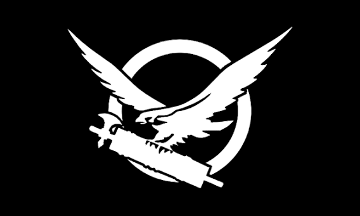
VA Flag
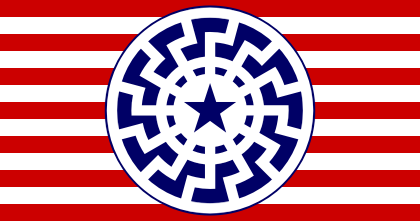
VA Flag (variant)
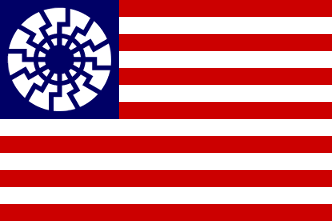
VA Flag (variant)
|
Vanguard America (United States)
Vanguard America (VA) is a white supremacist group that believes that America should be an exclusively white nation. Using a right-wing nationalist slogan "Blood and Soil", VA romanticizes the notion that people with "white blood" have a special bond with "American soil." Vanguard America has been reorganized and renamed several times. Earlier names included the Atomwaffen Division (AWD), the American Reaction, the American Vanguard, Vanguard America, and finally the National Bloc. One splinter group became the Patriotic Front.
A Marine Corps veteran named Dillon Ulysses Hopper, calling himself "Dillon Irizarry ", from New Mexico, has been leading the group since early 2016. During a speech at a neo-Nazi gathering in Kentucky, Irizarry said that VA started in California in 2015 and that he took over leadership about a year later. At that time he claimed that Vanguard America had approximately 200 members, in 20 different states.
The flag of the Vanguard America is black, with an eagle grasping a fasces, superimposed over a ring, all in white. It has a variant that adds the words "Vanguard America" beneath the eagle emblem. Another variant reportably uses a flag derived from the Stars and Stripes, with a Black Sun replacing the stars in the canton.
As part of the White Nationalist Alt-Right demonstrations held in Charlottesville in 2017, the Vanguard flags were prominently displayed on the nationally televised coverage.
Also see: Patriot Front. |
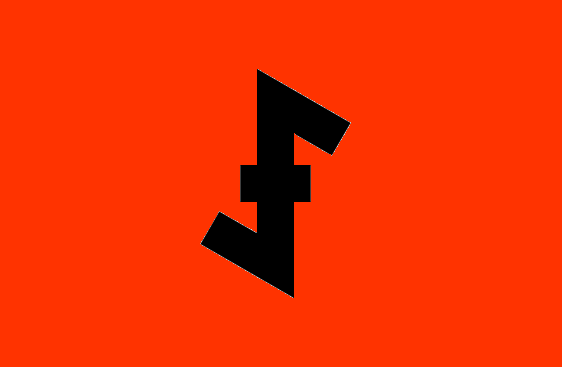
VAM Flag
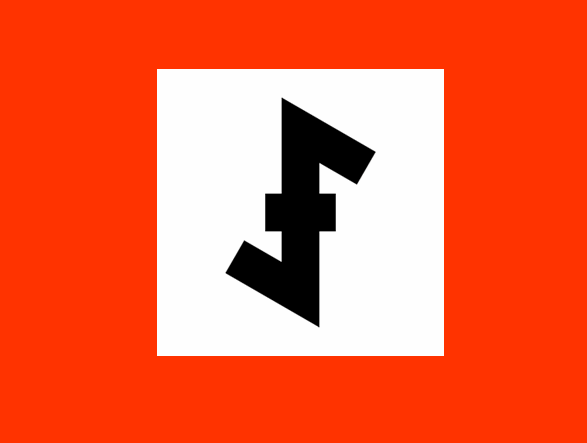
VAM Flag (suspect variant)
|
Swedish White Aryan Resistance Movement 1991-1993 (Sweden)
Vitt Ariskt Motstånd
The Swedish White Aryan Resistance Movement (VAM) was a short-lived Swedish, militant Neo-Nazi organization active between 1991 and 1993. The group was styled on the defunct US White supremacist group "The Order," led by Robert Matthews. VAM was founded by Klas Lund, Torulf Magnusson and Peter Melander, editor of the group's magazine "Storm." The organization's symbol was the "Wolfsangel."
In its short existence, VAM was implicated in many serious crimes in Sweden, including the infamous Police-murders in Malexander, car bombings of political journalists and murders of perceived opponents. According to a report prepared and jointly published in November 1999 by Sweden's four largest daily newspapers, Aftonbladet, Expressen, Dagens Nyheter and Svenska Dagbladet, many former members of this violent organization are now members of present-day neo-Nazi organizations.
After VAM, Klas Lund went on to organize the Swedish Resistance Movement. Another VAM off-shoot is the Swedish National Socialist Front which was formed in 1994 by VAM sympathizers in Karlskrona. |

VNV Flag (type #1)
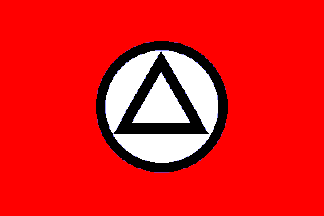
VNV Flag (type #2)
|
Flemish National Union 1933-1945 (Belgium)
Vlaamsch Nationaal Verbond
The Vlaamsch Nationaal Verbond (VNV) was a Flemish Nationalist Socialist political party in Belgium, founded by Staf de Clerq in 1933. De Clerq became known as "den Leider" (The Leader). The VNV was tied to the idea of uniting the many Flemish parties in Belgium into a single movement, and the creation of a pan-Dutch state, called Dietsland, to include both Flanders and the Netherlands. Its slogan was "Authority, discipline and Dietsland."
De Clerq died suddenly in 1942, and was succeeded by Hendrik Elias. Elias continued the collaboration with the Germans, but also tried to prevent the installation of a civilian government, which would be composed of Nazis. Elias failed, as Hitler installed the new body and declared the annexation of Flanders by Germany in 1944. Seven weeks later, Belgium had was liberated by the Allies. The VNV was outlawed after the war, and Elias was put in prison.
The flag of the VNV is orange with a white disc bordered blue and charged with a blue voided triangle. Blue, white and orange are the colors of the (united) Netherlands. The blue triangle is the delta symbol, the Netherlands being the delta of major European rivers: Rhine, Meuse and Scheldt. There was also a red/black/white version that was widely used. This one was based directly on the swastika flag of Nazi Germany, using the exact same colors. |
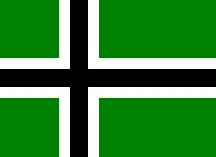
Vinland Flag
|
Vinland Flag (USA)
The Vinland flag is a contemporary flag first used by the musical group "Type O Negative" to encompass a variety of leader Peter Steele's interests and political beliefs, including his own Icelandic heritage. The flag is designed in the style of a Nordic Cross flag, with a green field and a black cross with white fimbriation, the green and black being a common color scheme for Type O Negative.
The Vinland flag is used by white racists worldwide to represent a unified homeland containing North America, Greenland, Iceland and northern Europe. Vinland flags are also sold by Stormfront.org, a neo-Nazi website. |
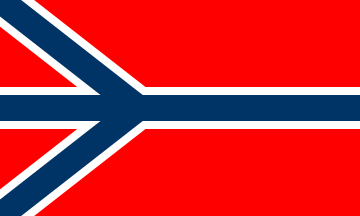
Vigrid Party Flag
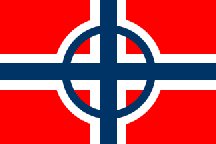
Vargsmal "Vigrid" Flag
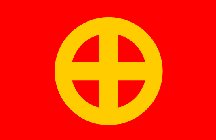
Nasjonal Samling 1933-1945
|
The Vigrid Party (Norway)
Vigrid is a Norwegian neo-Nazi organization which combines racial teachings with the imagery of Norse mythology. Vigrid was founded in 1998, and in 2009 they ran for the parliamentary elections, but received less than 200 votes.
The way Vigrid combines racist teachings with the imagery of Norse mythology is also visible in their flag, which is derived from Norwegian national flag by replacing the cross with the "life rune" shape.
Vigrid claims that non-Aryans are guilty of all the turmoil and problems around the world. They argue that the white race needs protection against extinction because of increased immigration of non-Aryans. They consider Adolf Hitler as a "savior," and deny the Jewish Holocaust claiming that the Jews were killed in the Allied bombings. They believe that the Jews now exploit the Holocaust for political and financial support. They are also appear to oppose Christianity, Islam, blacks and gays, but claim to distance themselves as a group from the use of all "offensive" violence.
The Vargsmal "Vigrid" flag, displaying a fimbriated sun disc centered on the Norwegian National flag is also attributed to them, especially on publications and their website. The Vigrid has also been known to display versions of the flag of the World Church of the Creator as well.
These flag design are taken from a book called Vargsmal. It was written by Varg Vikernes, a Norwegian black metal musician, convicted murderer, arsonist, and religious, political and nationalist activist.
The Third flag shown here is that of the Norwegian Nazi party Nasjonal Samling, which also used this golden sun cross on a red background as its official symbol from 1933 until 1945. The cross within a circle was ascribed to Saint Olaf, the patron saint of Norway, and the colors were those of the coat of arms of Norway. |
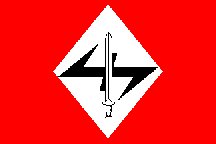
VAM Flag

VAM Flag (black variant)
|
White Aryan Resistance (Sweden)
The White Aryan Resistance (Vitt Ariskt Motstånd - VAM), was a militant neo-Nazi group active in Sweden in the years 1991-1993. The name of the group was taken from the US White supremacist organization WAR. VAM was founded by Klas Lund, who later went on to organize the Swedish Resistance Movement (Svenska Motståndsrörelsen) and the National Socialist Front (Nationalsocialistisk Front, NSF) which was formed in 1994.
The symbol behind the sword is the ancient German rune for "Wolf's Angel," or werewolf. In the past this rune was a magical means to frighten away werewolves. According to ancient superstitions men were sometimes transformed into beings, half men, half wolves, that were extremely blood-thirsty and ferocious. These beings were called werewolves. In World War II, this sign was used by the Division Waffen SS Das Reich.
This National Socialist flag features the "Wolf's Angel" sign, and was used in Sweden in the 1990s. Two variants of the flag are shown to the left, but the one with the red field was used the most.
It is interesting to note that "Werewolves" was the name chosen for the guerrilla fighters Hitler and the Nazi planned to use to continue the fight against the invading Allies when Germany’s Wehrmacht was defeated and the German territory was occupied. |
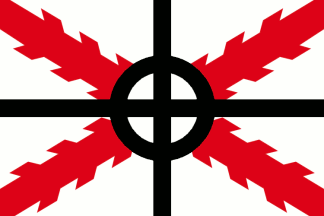
VB Flag
|
White Vision (Mexico)
Visio'n Blanca
The White Vision is a Mexican neo-Nazi group which claims to be the only true follower of National Socialism in the country and declares its goal to be the "protection of white race", which would eventually be achieved by creation of a separate country for Mexican people of European origin. These, according to them, should not be considered Mexicans any longer, but a separate nation, called simply the Creoles (El Criollos).
The flag of White Vision is derived from the Cross of Burgundy flag, which symbolizes the Spanish origin of Creoles, by superimposing a black Celtic cross with arms extended up to the flag edges, thus employing the complete set of Nazi colors. |
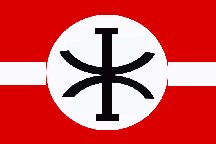
Vlajka Flag
|
The Flag Movement 1928-1942 (Czech Republic/Slovakia)
Vlajka
Vlajka, which means in Czech "The Flag," was the name of a Czechoslovakian fascist and nationalist movement which became politically active in the 1930s. Their leader was Jan Rys-Rozsévac, a journalist and politician. The group publication, also called "Vlajka," was founded in 1928, its first editor was Miloš Maixner.
During 1939-1940 Vlajka organized mass meetings against politicians of the First Republic of Czechoslovakia. Vlajka was disbanded at the end of 1942 after it lost the support of the German occupational forces and the Vlajka leadership, including Rys-Rozsévac, were sent as "privileged" prisoners to the Dachau and kept here until the end of the war. After the war Rys-Rozsévac, and three of his co-workers (Josef Burda, Jaroslav Cermák and Otakar Polívka), were sentenced to death by Czech authorities. |
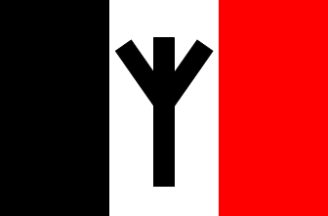
Volksfront Flag
|
Volksfront Flag (USA)
The American neo-Nazi organization Volksfront, headquartered in Oregon, wants a white homeland in the Pacific Northwest. The group was founded in 1994 in the Oregon State Penitentiary by Randall Krager. Although, since its formation, the group claims to have chapters in Oregon, Massachusetts, Arizona, California, New York, Pennsylvania, North Carolina, South Carolina, Washington State, Illinois, and Missouri, they only had approximately 100 members in 2007.
The Southern Poverty Law Center (SPLC) has added Volksfront to its list of hate groups. The Anti-Defamation League has called the group "one of the most active skinhead groups in the United States." The flag of Volksfront is a vertical tricolor of black-white-red with a black life rune centered on the white stripe, and while it seems to be based on an earlier design used by the National Alliance in the 1970s, no actual connection between the two extremist groups is known. |

WPP Flag
|
White Panther Party 1968-1985 (USA)
The White Panther Party was a far-left, anti-racist, white American political group founded in 1968. It was organized by Pun Plamondon and John Sinclair in Detroit, Michigan. The WPP was started as a way that "white people" could help support the policies of Huey Newton's Black Panthers. The group included a popular Detroit punk rock band named the MC5, which John Sinclair managed for several years. As its actions grew more radical over time, it eventually led to a bombing of a CIA recruitment office in Ann Arbor. This eventually resulted in the arrest and conviction of several of its leaders, including John Sinclair and Plamondon. In 1972 decisions by both Federal Supreme Court and Michigan Supreme against illegal wire taping and Michigan's current marijuana laws resulted in both Plamondon and Sinclair's convictions being reversed. The White Panther Party in Michigan, which had in the meantime renamed itself the "Rainbow People's Party", was disbanded in 1973.
However, White Panther Party activities continued to live on in Oregon and California until the mid-1980s. In Portland, Oregon, two members of the group were arrested and accused of throwing a Molotov cocktail through the window of a local Selective Service office which pretty well ended activities there. The White Panther Party chapters in San Francisco and Berkeley ran a successful food program that provided groceries to about 5,000 Bay Area residents at low cost in the late 1970s and early 1980s. They held "White Panther's People's Ballroom" concerts in Golden Gate Park in San Francisco, petition drives against handgun bans in San Francisco, and in 1984, a successful WWP petition drive actually forced a recall election of San Francisco's Mayor Dianne Feinstein, which failed. Further violence between the San Francisco Police Department and WPP eventually resulted in the WWP also being disbanded in the SF Bay Area in 1985. |
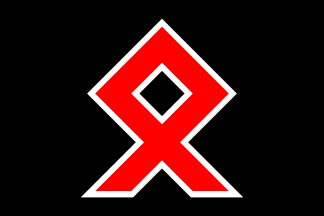
WJ Flag
|
The Viking Youth (Germany)
Wiking-Jugend
The Viking Youth was modeled after the Hitler Youth and named after the Viking League (Bund Wiking), a far-right movement from the 1920s, as well as the SS Division "Wiking." It was founded in 1952, after the Socialist Reich Party and its youth wing, the Reich Youth, were banned. Originally led by Walter Matthaei, former leader of the Reich Youth who emigration to Spain, it was taken over by Raoul Nahrath, who was succeeded first by his son Wolfgang and then by his grandson Wolfram, thus founding an informal dynasty of Nazi leaders. It was registered in 1974 in Stolberg, North Rhine-Westphalia, and in Berlin since 1991. The attempt to register its branch in Austria was rejected in 1980, the decision confirmed by the Constitutional Court the next year. In 1994, the main body was banned by the Federal Ministry of the Interior, which was confirmed by the Federal Administrative Court in 1999. It was the largest neo-Nazi youth movement at the time, with 400 to 500 members.
The Viking Youth used a black flag with large red odal rune, fimbriated white. This symbol was banned along with the party. |
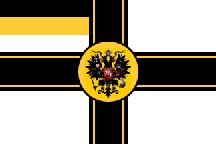
White Legion 88 Flag
|
White Legion 88 Flag (Russia)
This flag is, of course, a variation of the Imperial German War Ensign, undoubtedly inspired by German World War I and World War II flags, and used by the Russian neo-Nazi organization White Legion 88.
Eighty-eight is used as code among Neo-Nazis to identify each other. H is the 8th letter of the alphabet, so 88 is taken to stand for HH which in turn means Heil Hitler. For example, the number is used in the song "88 rock'n'roll band" by the neo-Nazi group Landser. The late convicted Order terrorist David Lane wrote "Fourteen Words" and 88 Precepts, and the numbers are often found in combination (1488, 14/88, etc.). This form of the number has inspired the naming of the groups Column 88, Unit 88, and White Legion 88. |
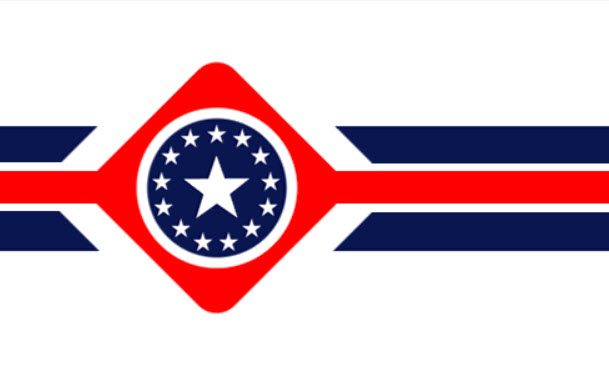
WN Flag
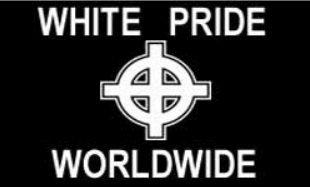
Combat 18 Flag
|
White Nationalists (USA)
The White Nationalist movement is a loosely connected group of small racial, skinhead and extremist organizations sprinkled across the United States, all claiming to be affiliated nationally and internationally with a wide spectrum of similar hate groups. They include such groups as the American Third Position, or A3P, the American Freedom Party, Freedom 14, Combat 18, and the National Youth Front. Professing admiration for David Eden Lane, the American white nationalist founder of The Order, and a convicted felon who died while serving a 190-year prison, they pepper their demonstrations with a wide variety of flags and slogans such as Lane´s "We must secure the existence of our people and a future for white children."
Since 2010, members have also organized, co-sponsored or freely distributed literature at Tea Party rallies, including ones held in Georgia, Arkansas, Louisiana and California. Leaders, such as White nationalist lawyer William Johnson and others, speak at Tea Party gatherings, which seem to provide fertile ground for their prejudicial propaganda.
The horizontal red stripe on the WN flag is described as the bloodline of "our people flowing through the background white of our Race, the bold blue stroke representing the valor of our people through which our collective bloodline flows." The flag has 14 stars, 13 for the original "white"colonies, and one extra for their "struggle" for the future. The movement also uses a variety of existing supremist flags such as those of the Afrikaner Resistance Movement (#Type1), Blood & Honor, The Nationalist Movement, and the protest flag favored by the Tea Party - The Gadsden Flag.
|
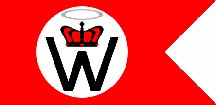
WCOTC Flag
(Swallow-tailed variant, filled halo)
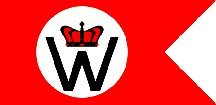
WCOTC Flag
Rectangular-shaped variant
(Mock white swallow-tail, no halo)

Creativity Movement Flag
(Swallow-tailed with hollowed halo)
|
World Church of the Creator Flag (USA)
One of the fastest-growing hate groups in the 1990s was the World Church of the Creator (WCOTC), based in East Peoria, Illinois, whose stated goal is "making this an all-white nation and ultimately an all-white world." The current group sometimes calls itself "The Creativity Movement" and is an often violent white separatist organization that advocates a whites-only religion, Creativity. They consider Jews and nonwhites, whom they refer to as "mud races," to be the "natural enemies" of the white race. The movement's use of the term creator, however, does not refer to a deity, but rather to themselves, and despite the formal use of the word Church in its name, the movement is atheistic.
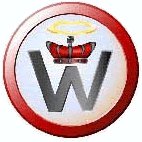
Current Creativity Movement Logo
(with gold hollowed halo)
Throughout the years there have been a series of slightly different variants of the WC flags and emblems reported and seen. The halos have been either gold or silver, hollow or not hollow, present or not present, and the flags themselves have been both swallow-tailed or mock swallow-tailed (with a white filled triangular shape on the fly instead of an actual swallow-tailed cut away). Currently the mock-swallowed tailed version seems most prevalent.
|
- My thanks to Rick Prohaska, David Ott, Tomislav Todorovic, and Chrystian Kretowicz for their help on this page -
Much of this information is borrowed, sometimes edited, modified, and shorten from longer articles in Wikipedia encyclopedia.
| Flags of Extremism Part 1 (a-m) | Flags of Extremism Part 2 (n) | Flags of Extremism Part 3 (o-z) |
|